Clifford Browder's Blog, page 42
February 22, 2015
168. Thomas E. Dewey, Gangbuster
In the suburb of Chicago where I grew up – a mostly white, very middle-class, very Republican community – the only crime wave was the depredations of a “phantom burglar” who for months eluded the police, becoming in the process both a bugbear and a legend. Real crime, and corruption too, existed just to the south of us in the wicked, corrupt, and very Democratic city of Chicago. But organized crime was almost unknown to us, something that reputedly flourished in that other, more distant big city, the wicked, corrupt, and very Democratic city of New York. (For white Midwestern suburbanites, all big cities were wicked and corrupt … and enticing.) But crime in New York, we understood, had been curbed by a stalwart defender of law and order, a special prosecutor and district attorney by the name of Thomas E. Dewey, a Republican who certainly deserved to be President.
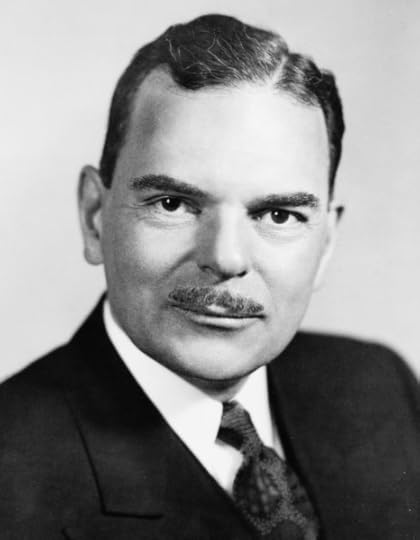
So it was that I knew him as a twice unsuccessful candidate for the presidency, a master of platitudes and glowing vague phrases: in his photos an earnest-looking, gentlemanly type, slim and dapper, with a well-trimmed mustache, whose opponents called him the “little man on the wedding cake.” A hard-working, diligent public servant, to be sure, and undeniably honest, but a bit lacking in color and warmth, two qualities that Harry Truman, his 1948 nemesis, had plenty of. But there is much more to Thomas E. Dewey than this, and his story is intimately linked to the history of New York City and State.
Born in Michigan in 1902, the son of a small-town newspaper editor, Dewey studied law and came to New York, where he started a lucrative practice on Wall Street. New York City in the Depression years of the 1930s was governed by Fiorella La Guardia, arguably the best, most honest, and most energetic mayor in the city’s history. But even under the Little Flower’s rule, many aspects of the city’s life were controlled by organized crime, which prompted cries for reform. In 1930 Dewey was appointed Chief Assistant U.S. Attorney for the Southern District of New York, to investigate corruption in the city. His first great success came in 1933 with the prosecution for tax evasion of racketeer and bootlegger Waxey Gordon, who was sentenced to ten years in prison. What may not have been known to the public was the fact that Gordon fell victim to a gang war; the evidence that did him in came from his rivals, the Sicilian-born gangster Charles “Lucky” Luciano and that supposed rarity, a Jewish mobster, Meyer Lansky: a first indication of the strange relationship between organized crime and the forces of law and order out to eradicate it.
In 1935 Governor Herbert H. Lehman, a Democrat, heeding a grand jury’s charge that the current D.A. was lax in investigating the mob and corruption, asked four prominent Republicans to serve as special prosecutor in New York; all refused and recommended Dewey. Appointed to this new position, Dewey recruited over 60 assistants, investigators, stenographers, and clerks, and proceeded vigorously, tapping telephones quite legally and employing his thoroughness and attention to detail to bring down organized crime.
And who exactly were his targets? The Commission, the governing body of the American Mafia, formed in 1931 to end the murderous wars between different factions for control of the Mafia. The Commission included the bosses of seven families: the five families of New York, the Chicago boss Al Capone, and the Buffalo boss Stefano Magaddino. The chairman of the Commission was one of the New York bosses, Lucky Luciano. Though the Commission was mostly Italian, and especially Sicilian, in origin, it allowed Jewish mobsters such as Meyer Lansky, Bugsy Siegel, and Dutch Schultz to work with them and attend some meetings. As a result, big-time crime in the U.S., and above all in New York City, was indeed truly organized and a force to be reckoned with, and Thomas E. Dewey was out to destroy it.
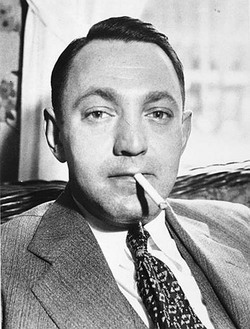 One of his chief targets was Dutch Schultz, whom J. Edgar Hoover’s FBI had labeled Public Enemy No. 1. A former bootlegger, at the end of Prohibition Schultz had switched to racketeering and extortion, using strong-arm tactics such as beatings and stink-bomb attacks to extract “dues” from terrified restaurant owners. Known for his brutality, when he suspected that an associate was cheating him, he confronted him angrily, whipped out a handgun, stuck it in the man’s mouth, pulled the trigger, and then apologized to another associate for killing someone in front of him. The victim’s body was later found in a snow bank with multiple stab wounds to the chest. When queried by the witness he’d apologized to, Schultz calmly replied, “I cut his heart out.”
One of his chief targets was Dutch Schultz, whom J. Edgar Hoover’s FBI had labeled Public Enemy No. 1. A former bootlegger, at the end of Prohibition Schultz had switched to racketeering and extortion, using strong-arm tactics such as beatings and stink-bomb attacks to extract “dues” from terrified restaurant owners. Known for his brutality, when he suspected that an associate was cheating him, he confronted him angrily, whipped out a handgun, stuck it in the man’s mouth, pulled the trigger, and then apologized to another associate for killing someone in front of him. The victim’s body was later found in a snow bank with multiple stab wounds to the chest. When queried by the witness he’d apologized to, Schultz calmly replied, “I cut his heart out.”It was not for these horrors that U.S. Attorney Dewey brought Schultz to trial, but for tax evasion – the same charge that would bring down Capone in Chicago. Schultz was convicted, but his lawyers got the case overturned and convinced the judge that their client could not get a fair trial in New York. So the trial was removed to the small town of Malone in rural upstate New York, where Schultz donated cash to local businesses, gave toys to sick children, and performed other charitable deeds, thus endearing himself to the locals. In 1935, to the astonishment of all, he was acquitted. Outraged, Mayor La Guardia ordered that Schultz be arrested on sight, should he return to the city, so Schultz relocated his operations to Newark, across the Hudson in New Jersey, where his mounting legal expenses forced him to reduce the pay of his underlings and thus undermined his authority.
Desperate, Schultz reportedly went to an emergency meeting of the Commission and asked permission to kill Dewey. The majority of the members voted against it, arguing that Dewey’s murder would stoke public fury and subject them to even more vigorous action by the authorities. Accusing the Commission of trying to steal his rackets and “feed him to the law,” Schultz left in a rage. Fearing that Schultz would act on his own, the Commission decided to eliminate not Dewey but Schultz. On the evening of October 23, 1935, two gunmen shot Schultz in the men’s room of a chophouse in Newark, and also killed two bodyguards and Schultz’s accountant. Gravely wounded, Schultz was taken to a hospital, where he lingered for 22 hours, delivering a rambling soliloquy while in and out of lucidity, before dying of peritonitis. Fearing conviction by Dewey, shortly before his death Schultz had had an airtight and waterproof safe built, into which he placed $7 million in cash and bonds. He and a bodyguard then transported the safe to an undisclosed site somewhere in upstate New York and buried it there. When Schultz and the bodyguard both died as a result of the Newark shooting, the location of the safe was lost. Gangland lore says that other mobsters searched for the safe over the years, and even today treasure hunters meet annually in the Catskills to hunt for it. So the legend of Schultz’s lost treasure has survived the memory of Schultz himself.
Only years later would Dewey learn of Schultz’s desire to murder him, but awareness of it would not have deterred him. Yet the threats to him were real, and La Guardia assigned a picked force of 63 policemen to guard his office. It was just as well, for his next target was none other than the mob’s kingpin, Lucky Luciano himself. Though born in Sicily, Luciano came to the U.S. at age 10 when his parents emigrated here and settled on the Lower East Side. As a teenager he got into crime and between 1916 and 1936 was arrested no less than 25 times for assault, illegal gambling, blackmail, and robbery, but spent no time in prison, which may explain how he got the nickname “Lucky.” Prohibition proved a windfall for him, and he and his partners were soon making millions through bootlegging. By the late 1920s he was involved in Mafia gang wars and survived an assault that was almost fatal, then in 1931 emerged as the chief organized crime boss in the U.S. and proceeded to modernize the Mafia, renouncing its strong-arm tactics for a corporate structure. His own crime family, one of five in New York City, controlled such rackets as illegal gambling, bookmaking, loan sharking, drug trafficking, prostitution, and extortion, and dominated waterfront activities, garbage collection, construction, the garment business, and trucking. Indeed, what did they not have a finger in? Luciano was now living high on the hog, with a suite (under another name) at the luxurious Waldorf Towers, and wearing custom-made suits, silk shirts, cashmere topcoats, and handmade shoes. He was often seen riding in a chauffeur-driven limousine or sporting about with a beautiful woman on his arm. Among his friends were George Raft and Frank Sinatra. But among his enemies was an energetic new U.S. Attorney out to destroy organized crime.
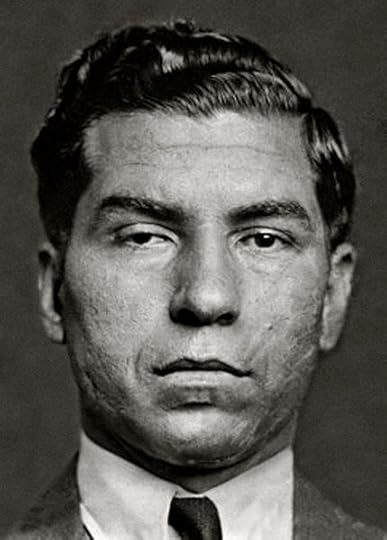 Luciano in 1936. Dewey decided to do it through Luciano’s involvement in prostitution. In February 1936 he conducted a massive raid on some 200 brothels in Brooklyn and Manhattan and arrested 10 men and 100 women. Instead of releasing those arrested, as was usual in vice raids, he took them to court, where the judge set bail at a figure too high for them to pay. Confinement and the threat of prison worked wonders: by March several defendants had implicated Luciano, who, being tipped off about his imminent arrest, decamped for Hot Springs, Arkansas, a favorite hangout for mobsters at the time. There in that healing environment his luck ran out, for a detective on another assignment recognized him and notified Dewey, who had him arrested and sent back under guard to New York, where he was held without bail and then tried on 62 counts of compulsory prostitution.
Luciano in 1936. Dewey decided to do it through Luciano’s involvement in prostitution. In February 1936 he conducted a massive raid on some 200 brothels in Brooklyn and Manhattan and arrested 10 men and 100 women. Instead of releasing those arrested, as was usual in vice raids, he took them to court, where the judge set bail at a figure too high for them to pay. Confinement and the threat of prison worked wonders: by March several defendants had implicated Luciano, who, being tipped off about his imminent arrest, decamped for Hot Springs, Arkansas, a favorite hangout for mobsters at the time. There in that healing environment his luck ran out, for a detective on another assignment recognized him and notified Dewey, who had him arrested and sent back under guard to New York, where he was held without bail and then tried on 62 counts of compulsory prostitution.The jury heard 68 witnesses, 40 of them prostitutes or madams. One told how Luciano had told her, “I’m gonna organize the cathouses like the A&P,” and quoted him as saying that “you got to put the screws on” to keep madams and pimps in line. Trusting to his proverbial luck and not knowing who he was up against, Luciano, against his lawyers’ advice, took the stand to proclaim his innocence and deny knowing the witnesses. It was a dramatic confrontation: the king of crime vs. the king of prosecutors. Dewey subjected him to a rigorous four-hour cross-examination and repeatedly exposed him as a liar. Nor could Luciano explain why he, a man obviously of great wealth, claimed to earn only $22,000 a year. In his seven-hour summation Dewey labeled Luciano’s testimony “a shocking, disgusting display of sanctimonious perjury” and called the defendant “the greatest gangster in America.” On June 7, 1936, Luciano was found guilty on all counts and sentenced to 30 to 50 years in state prison. It was U.S. Attorney Dewey’s greatest triumph.
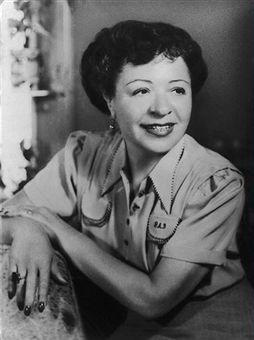 Polly Adler, celebrated madam and
Polly Adler, celebrated madam and author. Maybe we'll see her again. Since then many have questioned whether there was adequate evidence to convict Luciano, since he, like most mob bosses, avoided any direct and obvious connection with his illegal activities. Society brothel madam Polly Adler, later the author of the bestseller A House Is Not a Home, opined that Luciano was not involved in prostitution, since otherwise, having operated under mob protection, she would have known of it. But Dewey was now hailed as a gangbuster – a neologism that soon become the name of a popular radio show – and as such a national hero. He got results – 72 convictions out of 73 prosecutions -- and Americans love results.
A Republican in a very Democratic town, in 1937 Dewey got himself elected District Attorney of New York County and as such continued to prosecute mobsters and other offenders. Among the latter were Richard Whitney, a former president of the New York Stock Exchange, who pleaded guilty to embezzlement, and Fritz Kuhn, leader of the pro-Nazi German-American Bund, who was convicted of the same charge. Cheered by the successes of so stalwart and effective a champion of justice, the state’s Republicans, long out of office in Albany, began urging him to run for governor. And so began the transition of Dewey the gangbuster to Dewey the politician.
Coming soon: Dewey the politician, and why he never became President. And then, the dumpy little lady who became a friend of Maria Callas and everyone else who mattered (or thought they did), and who allegedly used Marilyn Monroe to snub the Duchess of Windsor. A glance at the world of the rich, the famous, and the no doubt totally irrelevant. But if you ever went on a treasure hunt or a scavenger hunt, you’re indebted to her.
© 2015 Clifford Browder
Published on February 22, 2015 05:35
February 15, 2015
167. Chief Medical Examiner: A Grim but Necessary Job
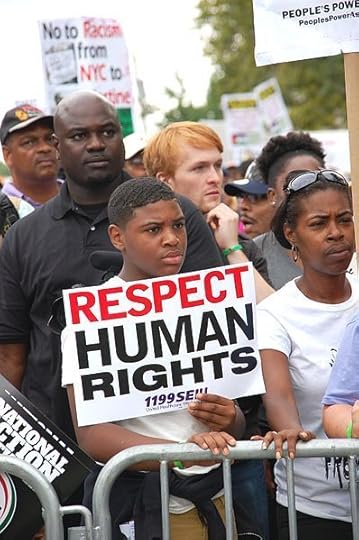 Protesting Eric Garner's death, August 2014.
Protesting Eric Garner's death, August 2014.Thomas Altfather Good Recently the refusal of a grand jury to indict a New York City policeman for the chokehold death on Staten Island of Eric Garner, an unarmed African American, unleashed a frenzy of protests in the African-American community, some of which turned violent. But before this case could even be brought to the grand jury, Garner’s death had to be investigated and declared a homicide by the office of the city’s chief medical examiner, an important official whom most New Yorkers know little or nothing about. So who is this official and what are his duties? (Usually it has been a man, but at this moment it’s a woman, Dr. Barbara Sampson.)
In the nineteenth and early twentieth century New York City had several county coroners who investigated violent, sudden, or suspicious deaths – in short, any deaths not obviously the result of natural causes. This was an elected office, and to become a coroner your political connections were far more important than your medical training, or lack of it. As a result, the office of coroner became notorious for corruption and incompetence, and an outcry arose for reform. In 1915 the state legislature abolished the office and replaced it with something new: the office of chief medical examiner (CME), an official with formal medical training and experience who was appointed by the mayor. This new office was meant to be nonpartisan, objective, and completely free from political influence – a goal that, as shall become apparent, has not always been easy to achieve.
So what does the chief medical examiner do? He (or she) investigates all deaths resulting from criminal violence, accident, or suicide, and all that occur suddenly when the person is in apparent good health, and all occurring in any unusual or suspicious manner. He takes possession of suicide notes and all objects useful in determining the cause of death, maintains records of all deaths investigated, and delivers to the appropriate district attorney copies of records relating to any death that may have resulted from criminal activity. In a city the size of New York, such an office will have plenty of business. It employs some 30 medical examiners – most of them women -- who perform an average of 5,500 autopsies a year.
Few New Yorkers know where the chief medical examiner’s facilities are located, and few, I suspect, would care to visit them. The six-story headquarters building at 520 First Avenue, on the corner of East 30th Street, houses executive offices, the mortuary, autopsy rooms, and x-ray and photography facilities. Another building at 421 East 26th Street has state-of-the-art forensic laboratories where technicians in white protective gear and purple gloves examine bloodstained clothing and half-smoked cigarettes from crime scenes; there is even a forensic garage to examine vehicles for evidence relating to a death or deaths.
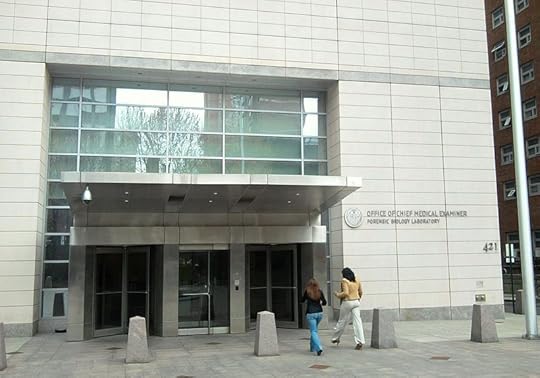 The forensic lab on East 26th Street. On the outside, well-scrubbed and neat.
The forensic lab on East 26th Street. On the outside, well-scrubbed and neat.So what is it like to work in the medical examiner’s office? Judy Melinek’s memoir Working Stiff: Two Years, 262 Bodies, and the Making of a Medical Examiner (2014), coauthored with her husband, gives some juicy details. I’ll spare viewers her accounts of autopsies, but other reminiscences are colorful in the extreme. She laughs at TV presentations of female examiners in stiletto heels and lots of cleavage, for at murder sites she wore sensible shoes and a windbreaker. When considering where to launch her career as a medical examiner, she was told, “If you really want to learn forensic pathology, do a rotation in New York City. All kinds of great ways to die there.” Some of the weirdest deaths she investigated:
· A hipster struck by lightning during a rooftop party in Chinatown, his body intact but his shoes blown off.· A suicide who jumped onto the subway tracks and was so smashed by a train that no blood was visible, it all having been absorbed into the bone marrow.· A worker crushed to death when an enormous machine used to make egg rolls in Chinatown exploded.· A man who in a fight got thrown down an open manhole into a pool of boiling water from a broken main and screamed for help, but was literally cooked to death before rescuers could reach him.· A man who was shot in the chest, the bullet getting flushed into the circulatory system and ending up in his liver.
A trick she learned from the police: When recovering a body from an apartment building, ask every tenant to make coffee; it covers the smell.
And advice to those who live alone with a cat. While a dog may sit next to your body for days, starving, be advised that your hungry cat will eat you right away. “I’ve seen the result.”
 A heart perforated by a bullet in New York, 1937.
A heart perforated by a bullet in New York, 1937.The sort of thing the CME's office deals with regularly. Which makes one wonder why anyone in their right mind would want to be a medical examiner, recover bodies, and perform autopsies. But someone has to do it, and human motivation is diverse and mysterious. I once heard a male hospital intern tell another intern, “When I saw my first surgery in medical school, I said to myself, ‘That’s what I want to do!’ ” From surgery to save a life to doing an autopsy is probably but one short step.
Few New Yorkers know the name of the chief medical examiner or notice when one retires. Especially averse to publicity was Dr. Charles S. Hirsch, the CME from 1989 to 2013, who retired quietly at age 75. Mayor Bloomberg hailed him as a visionary and dedicated public servant to be especially remembered for his work in the aftermath of 9/11. On that occasion he and six aides rushed immediately to establish an on-site temporary morgue. When the first tower collapsed, he was hurled to the ground, bruising his body and breaking his ribs. Covered with white dust, he returned to his office, a ghostlike figure, to oversee the immense task now facing them: to identify some 20,000 body parts of victims that were collected over the days, weeks, and months that followed. Of the 2,753 people killed or missing, as of 2013 only 59 percent had been identified. For years he kept on his desk a glass bowl containing dust retrieved from his pocket after he was knocked to the ground that day.
Dr. Hirsch was respected for his refusal to bend to public opinion or the influence of the police, emphasizing his commitment to independent autopsies, “the only kind of autopsy I know how to give, whoever I may be working for.” This was a sharp contrast to the behavior of a predecessor, Dr. Elliot M. Gross, the CME from 1979 to 1987. In 1985 the New York Times ran a series of articles accusing his office of mishandling several cases of people dying in police custody, always to produce results favorable to the police. Among the highly controversial cases involved were these:
· Eleanor Bumpurs, an emotionally disturbed 66-year-old African American woman who brandished a 12-inch kitchen knife and was shot to death in the Bronx 1984 by six police officers trying to evict her. When the medical examiner found that she was hit by two shotgun blasts, Gross had the cause of death reworded to suggest only one blast, as the police had reported. The officer who fired the shots was tried for manslaughter but was acquitted. The city later settled with Bumpurs’s family for $200,000.· Ralph Tarantino, a 29-year-old Brooklyn man high on angel dust who in 1980 was beaten to death by police officers summoned because of a dispute between him and his neighbors. When an autopsy attributed the death to a fractured skull, Gross changed the finding to make the cause of death a procedure performed by doctors treating his injuries. An independent pathologist called Gross’s finding “irresponsible.”· Mark Safdie, a 32-year-old Brooklyn storeowner, whose wife called the police in 1983 when he began acting irrationally. The police forced him to the floor, handcuffed him, punched him, and refused to let his wife come near him. Taken to a hospital, he was dead on arrival. Gross’s autopsy report didn’t link his injuries to his death, which he attributed to “manic depressive psychosis with acute violent behavior.” A lawyer for the Safdies called the report a “whitewash.” · Michael Stewart, a 25-year-old African American subway graffiti artist who was arrested by transit police in 1983 for spray-painting graffiti on a subway wall. When he resisted arrest, he was beaten unconscious. After being booked at police headquarters, he was transferred to Bellevue Hospital, where he arrived handcuffed and comatose and died without regaining consciousness. Gross’s preliminary autopsy report asserted that he died of heart failure following a heart attack that put him in a coma – a report challenged by a physician witnessing the autopsy on behalf of the family. Gross’s later report declined to state explicitly what caused Stewart’s death. Six of the 11 white officers involved were tried on manslaughter and homicide charges and acquitted by an all-white jury.
A panel appointed by Mayor Ed Koch to study Gross’s conduct absolved him of misconduct but criticized his management. In 1987, when a second mayoral panel reached similar conclusions and recommended that he be replaced, Koch fired him, citing a need for new leadership in the office. Gross then sued the Times for libel, but in 1992 the Appellate Division of the New York State Supreme Court found in favor of the Times, declaring that the complained-of language did not constitute defamation of character.
It is generally thought that the CME’s office under Dr. Hirsch has undergone a vast improvement unless, of course, one believes the New York Post, a tabloid specializing in sensationalist headlines. In an article of July 20, 2014, it chronicled these problems:
· The office has received $19.6 million in federal Homeland Security grants since 2005, but refuses to explain how it has spent the funds.· One official has traveled at taxpayer expense to conferences in Las Vegas, the Hague, Hong Kong, and Israel, and another to Croatia and Thailand.· The number of investigators who examine bodies at death scenes has been cut from about 40 to 20, and the work is suffering.· Examiners have removed brains and other organs from bodies without informing the next of kin retrieving the bodies for burial.· A body had to be dug out of a grave in New Jersey because it had been delivered to the wrong funeral home.· A body was sent to the wrong crematorium not once but twice.· Another body was lost, causing the office to dig up 300 graves in a Bronx potter’s field in an unsuccessful attempt to recover the remains.· The body of an 85-year-old woman was sent by mistake to a medical school to be used in anatomy classes, even while her son was making funeral arrangements; it was returned with embalming devices attached, blood spatters, and stitches on her lips and neck, causing trauma for her grieving son.
The Post concludes that the office has a history of criminality, waste, and incompetence, while millions of dollars of taxpayers’ money have been spent on plans and equipment useful only in a mass disaster, even though medical examiners are not first responders. Serious charges, but charges requiring verification from a more reliable source. But the current CME, Dr. Sampson, acknowledges that mistakes have occurred and emphasizes steps taken to avoid similar mistakes in the future, while stressing that the science performed in the lab was never in question.
And what happens when the Office of Chief Medical Examiner receives an unidentified body? The body is fingerprinted and photographed, and the fingerprints are sent to state and federal law enforcement agencies for comparison with their records. If the body’s condition makes fingerprinting impossible, or no matching records are found, dental X-rays are taken and compared with X-rays from the decedent’s dentist, if available. If a skeleton is recovered, it is analyzed to determine age, race, sex, and other characteristics. And if the remains are still unclaimed or unidentified, they are interred in the city cemetery on Hart Island, a forbidden island where living visitors are most unwelcome, as described in a previous post (#49, New York Hodgepodge, March 3, 2013).
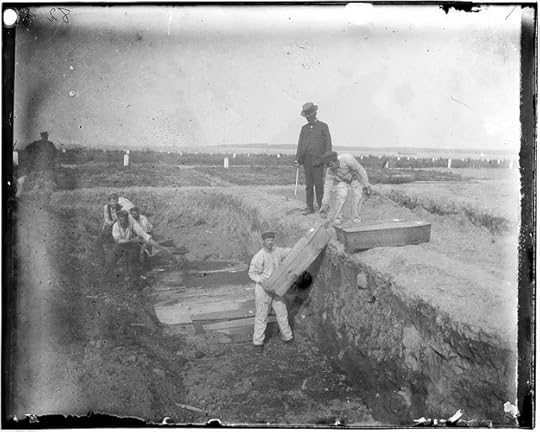 Burying coffins on Hart Island, circa 1890. A Jacob Riis photograph.
Burying coffins on Hart Island, circa 1890. A Jacob Riis photograph.The Chief Medical Examiner’s office also tries to locate missing persons. On November 8, 2014, it sponsored a first-ever Missing Persons Day, meeting with over a hundred families trying to locate a missing family member. Families provided information to relevant professionals, and volunteers were on hand to offer emotional and spiritual support. Big cities like New York are often viewed as bottomless dark holes into which individuals can vanish without trace. Using an array of state-of-the-art techniques, the CME’s office is trying hard to combat that impression.
But for all its efforts, many bodies remain unidentified. Yet a novel program is now under way to help cope with this problem. An article in the New York Times of January 21, 2015, tells how in room 501 of the New York Academy of Art in Manhattan a roomful of sculpture students are molding clay into faces that look almost alive. But the people represented in the sculptures aren’t just anyone; they are people who had met ugly deaths, usually by violence, and whose remains were found in desolate places throughout the city: on train tracks, in wooded areas, in dark basements. What’s going on?
These victims are all unidentified, and this is a workshop where fine art students are trying to recreate their faces so as to help the CME’s office identify them, comfort relatives, reopen cold cases, and in cases of homicide perhaps find the killers. Each student is given the replica of a skull and then, using any available information regarding age, sex, height, hair type or style, and clothing sizes, as well as a knowledge of anatomy, molds a block of clay into a lifelike face that, with marbles for eyeballs, slowly takes shape. Artistic license is not allowed, only accuracy. “I felt like he was talking to me,” said one student, “and that he’d be happy I was doing this for him.”
This is a unique and pioneering last-ditch effort, combining art and forensics, to identify these remains; if successful, it will be expanded to include more of the 1,200 bodies still unidentified by the CME’s office over the past 25 years. Photos of the sculptures will be turned over to New York police investigators and posted on an online public database of missing persons run by the National Missing and Unidentified Persons System. Will identifications result? The class instructor, whose own sculptures of anonymous skulls for another organization in Virginia have yielded 30 hits, thinks so, but only time will tell.
Coming soon: Two posts on Thomas E. Dewey – one on him as a fearless gangbuster who brought Lucky Luciano, the Mafia kingpin, to trial (and then released him), and one on him as a politician who lacked one quality necessary to get into the White House. After that, a short, dumpy hostess who said she belonged to the world and used Marilyn Monroe to snub the Duchess of Windsor.
© 2015 Clifford Browder
Published on February 15, 2015 04:34
February 11, 2015
166. Great Hotels of the Past and Present, part 2
Discussed in the last post, the Waldorf and Plaza are massive, hosting hundreds of guests every day. But there are smaller hotels of distinction as well. At the top of the list I would put the Algonquin at 59 West 44th Street, between Fifth and Sixth avenues. Built in 1902 with a red brick and limestone façade and named for the Indians who once lived in this area, it has a mere 181 rooms, small indeed compared to the Plaza and Waldorf. Frank Case, its longtime manager and owner, was fascinated by actors and writers and therefore welcomed them to his hotel and extended them credit. Among the habitués he snagged over the years were Douglas Fairbanks, Sr., John Barrymore, Sinclair Lewis, and William Faulkner, but he was a bit ahead of his time in welcoming women as well, including Gertrude Stein, Helen Hayes, and later Simone de Beauvoir. But what made the Algonquin famous was the Algonquin Round Table.
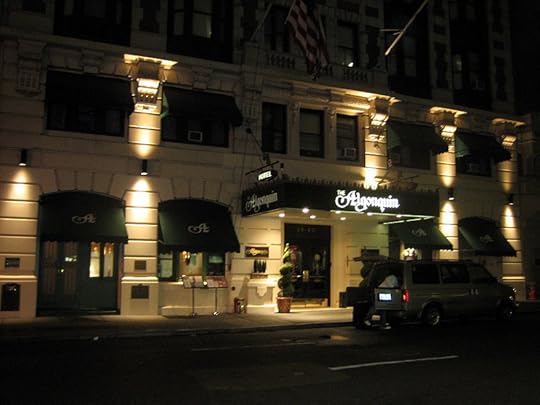 The Algonquin at night.
The Algonquin at night.Initiated in 1919, the Round Table was a select group of journalists, authors, critics, and actors who met daily for lunch in the main dining room, where they had their own table and waiter and exchanged opinions and witticisms and gossip. Prominent among them were humorist Robert Benchley, playwright and director George S. Kaufman, writer and critic Dorothy Parker, New Yorker editor Harold Ross, playwright Robert E. Sherwood, and critic Alexander Woollcott. Others who were in the group at times included actress Tallulah Bankhead, novelist Edna Ferber, and comedian Harpo Marx, always mute in his films but who in this select company presumably permitted himself to speak.
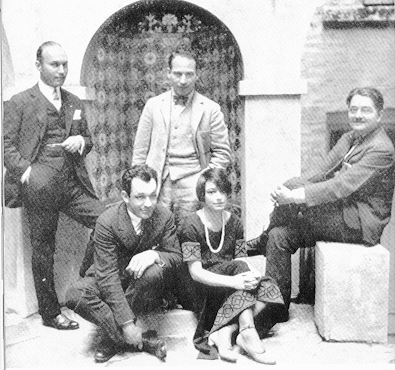 Members of the Round Table, circa 1919. Back row, from left:
Members of the Round Table, circa 1919. Back row, from left:Art Samuels, editor of Harper's Bazaar; Harpo Marx; Alexander
Woollcott. Front row, from left: playwright Charlie MacArthur;
Dorothy Parker. And how many of these names ring a bell today?
Besides exchanging chitchat, the Round Table members played poker and charades, staged a one-night revue, and acquired a reputation as wits when their quips and doings were reported widely in the press. But those quips could be mordant, and not for nothing had they named themselves “the Vicious Circle.” Critic H.L. Mencken, admired by them but emphatically not a part of the group, asserted that “their ideals were those of a vaudeville actor, one who is extremely ‘in the know’ and trashy.” And Groucho Marx observed, “The price of admission is a serpent’s tongue and a half-concealed stiletto.” It is true that they were probably more proficient in wisecracks than in meaningful insights, that they were arrogant and promoted themselves shamelessly, that in the last analysis most of them were not consistently and profoundly creative.
The Round Table flourished through the 1920s but then flaked away, it isn’t quite clear why. Edna Ferber knew the game was up when she arrived for lunch one day and found the group’s table occupied by a family from Kansas. Others in time realized that they had nothing more to say to one another and drifted off into other ventures. But they survived in the collective memory and ultimately helped win the Algonquin New York City Historic Landmark status in 1987.
It is hard to recreate the atmosphere of the Round Table, but here are a few quotes:· Alexander Woollcott: “All the things I like to do are either immoral, illegal, or fattening.”· Robert Benchley: “Behind every argument is someone’s ignorance.”· George S. Kaufman: “Epitaph for a dead waiter – God finally caught his eye.”· Dorothy Parker: “If you want to know what God thinks of money, just look at the people he gave it to.”· Dorothy Parker again: “I don’t care what is written about me so long as it isn’t true.”
Yes, maybe the quips were rehearsed beforehand, and maybe they weren’t even uttered at the Algonquin. But they and the Round Table have become a cultural legend and as such merit a little respect … or at least a trace of a smile. Because what else of that cultural moment remains? Almost nothing.
Today the Algonquin promotes itself as a luxury hotel near the Theater District and just a block from the lights of Times Square, a boutique hotel rich in history and hospitality, with 37-inch TVs, backlit mirrors, and an iPod docking station in all the rooms. So even without Dorothy Parker and the Round Table, one can settle snugly in. I entered its hallowed precincts just once, years ago, before the addition of all these state-of-the-art amenities, when my uncle stayed there during a brief visit to the city and treated me to lunch in the restaurant. I can state without reservation that the vichyssoise soup that I had was, to put it mildly, out of this world; it vaulted me to the apex of joy.
A unique hotel – unique for many reasons – is the New York Palace Hotel, formerly the Helmsley Palace Hotel, at 455 Madison Avenue, in the very heart of midtown. It incorporates two very different structures that are linked by a two-story marble lobby: the landmark Italian Renaissance-style Villard Mansion, built by railroad magnate Henry Villard in 1884, and right smack against it, a 55-story tower built by real estate magnate Henry Helmsley in the 1970s; the resulting mishmash – or ingenious blend, if you prefer – opened as a luxury hotel in 1981.
 The New York Palace Hotel (formerly the Helmsley Palace Hotel),
The New York Palace Hotel (formerly the Helmsley Palace Hotel), with the Villard Mansion in front.
Americasroof
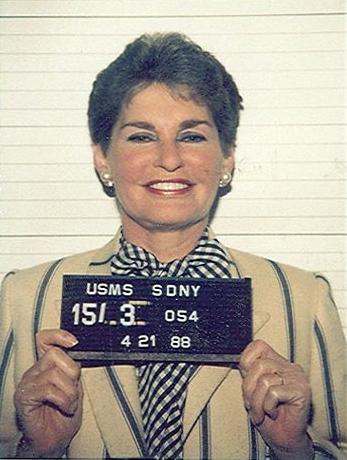 Leona Helmsley's mug shot. In spite of the glowing
Leona Helmsley's mug shot. In spite of the glowing smile, she ended badly. When you talk about the Waldorf Astoria, you end up discussing international relations. When you talk about the Algonquin, you end up discussing wit and witty people. And when you talk about the Helmsley Palace Hotel, you end up discussing Helmsley’s wife Leona, who managed the hotel from 1981 to 1992, and whose imperious presence has darkened these pages before (post #81, August 21, 2013). Since I have already chronicled her as the Queen of Mean, I shan’t honor her with further commentary. Suffice it to say that she terrorized the staff, but was finally undone by the federal government, which in 1989 convicted her on various charges including conspiracy, mail fraud, and tax evasion. What in my opinion doomed her irretrievably was testimony by her former housekeeper, who quoted her as saying, “Only the little people pay taxes.” That assertion the government simply couldn’t ignore, and didn’t. She served in prison from 1992 to 1994, when she was released with 750 hours of community service to perform, some of which she assigned to her servants, thus earning her another 150 hours of service.
When Leona died in 2007, she left $12 million to her beloved Maltese dog Trouble, who thus became the richest dog in the world and lived her last three years in security and comfort. They don’t make ’em like Leona anymore … at least, I hope they don’t. But the hotel, now rechristened the New York Palace Hotel, still flourishes, having been owned briefly by the Sultan of Brunei, and now by Northwood Investors, a New York-based real estate investment firm. Guest rooms start at $525 a night, and suites at $1,100. But I’m sure they’re comfortable.
And if you can’t afford such rates? You do what my mother did during a visit in the 1950s, you stay at the YWCA (or the WMCA), where she was quite comfortable. (It didn’t hurt that she’d once worked for the Y and was still in touch with friends she’d made there years before.) Or at some little budget hotel a bit off the beaten track, like the Larchmont at 27 West 11th Street in Greenwich Village, where single rooms range from $90 to $109 plus tax on weekdays – bargain rates indeed for Manhattan, and with a continental breakfast included. The neighborhood is residential and quiet, and the exterior of the hotel is modestly elegant. A friend once stayed there and I saw her room: small, with only basic furniture – a bed, a desk, a chair, little else. (The Larchmont now advertises a color TV in every room.) It was a place to lay your weary head at night, so you could rest up for forays into the city by day. Modest, but doable.
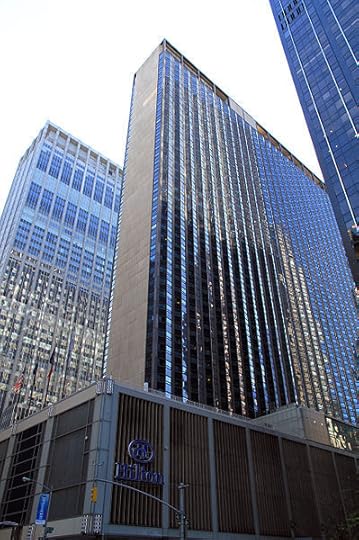 The Hilton Midtown with its soaring slabs. Clunky.
The Hilton Midtown with its soaring slabs. Clunky.Ingfbruno
And for those not interested in modest little budget hotels? How about the prestigious New York Hilton Midtown at the northwest edge of Rockefeller Center at Sixth Avenue and 53rd Street? A soaring 47-story building with 2,153 rooms in all, the biggest hotel in the city, it opened in 1963 and since then has hosted every U.S. president from John F. Kennedy on, as well as countless conferences and conventions. It has been called a microcosm of the city itself: vertical, crowded, diverse, and cash-driven. When it opened, New York Times architecture critic Ada Louise Huxtable commented: “If the building has a look that suggests that one might put change in at the top and get something out at the bottom, this is only because today’s slickly designed commercial structures more and more frequently resemble a product, a machine, or a package.” Certainly it lacks the grandeur of the Waldorf or the Plaza, and has been said to mark a shift from the gracious and luxurious to the utterly functional. To my eye it looks like a big box surmounted by a slab; in short, it’s clunky. But guests don’t come there because of the looks of its exterior, and many an online review praises it (appropriately) to the skies.
Another bit of flashy modernity, the Marriott Marquis Hotel at Broadway and 45th Street soars above the hurly-burly of Times Square. It was born in controversy, for five historic theaters were demolished to make room for it – a demolition dubbed “the Great Theater Massacre of 1982.” Yet it has also been hailed as the first major project in the revitalization of Times Square, which, contaminated by nearby 42nd Street, was then undeniably seedy, with an abundance of go-go bars and “adult” theaters. If the Marriott, opening in 1985, turned its back on Times Square, focusing attention inward on its soaring atrium, it’s because it wanted no part of that seediness.
 The Marriott Marquis, with the flashiness of Times Square in the foreground.
The Marriott Marquis, with the flashiness of Times Square in the foreground.Americasroof
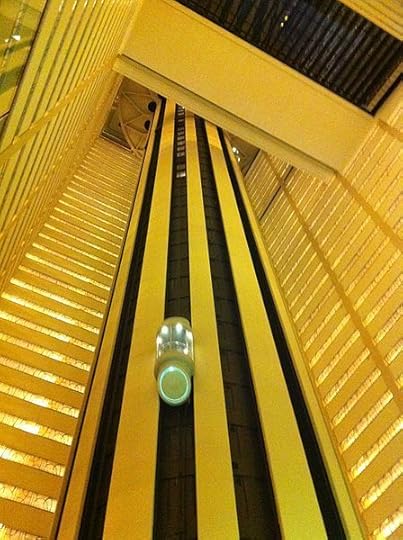 The glass-walled elevators. No thanks.
The glass-walled elevators. No thanks.haitham alfalah Two features especially distinguish this state-of-the-art structure, and I have experienced both. The glass-enclosed “scenic elevators” crawl up the sides of a central column in the building’s atrium like big bugs, giving views of its soaring inner space. Visitors are said to flock from miles away and stand in line to access them, but when I rode in one years ago there was no wait at all. But even though I have no abnormal fear of heights, I was distinctly uncomfortable, having the feeling that this creeping creature with glass walls had no support under it and could easily plunge; when I got off and felt a solid floor beneath me, I was vastly relieved. On the other hand, the famous revolving bar and restaurant on the 48thfloor is a unique and wondrous rooftop experience, slowly making a complete turn each hour while giving breathtaking views of the city. I was once there with visiting relatives at night, and the views of the lights of Times Square were unforgettable.
A less publicized fact about the Marriott Marquis is its popularity for suicides. Those planning it probably think they will plummet gracefully and land with a dramatic thump in the lobby. Not so. One jumper leaped from the 43rdfloor, but his right arm and left leg were recovered on the 11thfloor, his other two limbs on the 7th floor, and part of his skull in the elevator shaft. And another suicide, leaping from the 23rd floor, ended up with one leg on the 10th floor and his torso on the 9th. Why this dispersion of remains? Because the falling body bounces off a variety of obtruding structures on the way, each breaking off a different part of the body. So would-be suicides should definitely keep away from the Marriott. (I would recommend the Palisades, except for the fact that there’s lots of poison ivy over there. Besides, that’s in New Jersey, and my focus here is on New York.)
So as not to end on a grisly note, here are some tidbits about the Waldorf Towers and its residents, courtesy of two young women who are the Waldorf’s luxury suite specialists:
· The most requested suite: the Presidential, where every President since Kennedy has stayed. When a President is there, they install bulletproof glass.· The largest suite: The Cole Porter, where the composer lived for 25 years. It rents at $150,000 a month and up. His piano is still there.· A rare bit of presidential trivia: when President Roosevelt came, he arrived via an underground railroad running from Grand Central Station to the fourth floor of the Waldorf basement. That way no one saw him arrive in a wheelchair.· The suite with the biggest and most exquisite bathtub: the Elizabeth Taylor, whose tub is big enough for three. (There’s no report of its ever having accommodated a threesome, however.)· The weirdest request ever: a VIP insisted that they raise the toilet height by one centimeter, which they did.· Objects that guests steal as souvenirs; teakettles, silverware, plates, ashtrays, and a candelabra.
So far as I know, there is no Lucky Luciano Suite. With this hodgepodge of trivia, I conclude.
Note on post 162.5, Big Bank, Big Real Estate: The feature page-one article of the Sunday New York Times of February 8, 2015, tells how foreign billionaires are secretly buying luxury condos in the soaring glass towers sprouting all over midtown Manhattan. The article focuses on the two dark glass towers of the Time Warner Center at Columbus Circle, where condo buyers include a Chinese businessman whose properties in Jersey City have been investigated for unsanitary conditions; a Scottish businessman the collapse of whose investment firm in the U.K. lost the savings of 30,000 people; an Indian CEO of a global mining conglomerate responsible for severe pollution in India and Zambia; and a Russian oligarch accused of dubious financial transactions in Angola. Just identifying these buyers took the Times a whole year, as they went from source to source to source, unpeeling layers of secrecy.
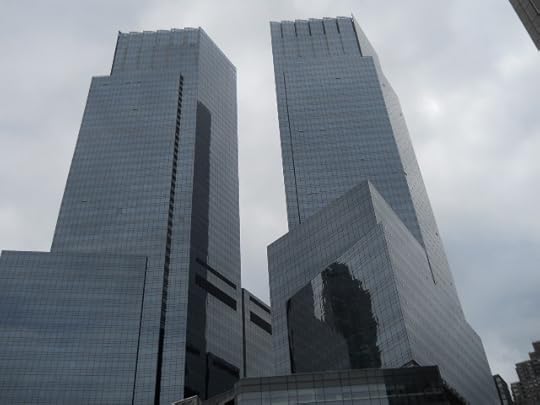 The Time Warner Center: more soaring slabs.
The Time Warner Center: more soaring slabs.Youngking11 These and other condo buyers obviously have good reason to desire anonymity, often buying condos in the name of a relative or a shell company such as an LLC (limited liability company), thus quite legally concealing their identity. Many of them are absentee owners who are here only sporadically, paying no city income tax and often receiving hefty property tax breaks as well. Our previous mayor, Michael Bloomberg, encouraged purchases by foreign billionaires, on the assumption that their lavish spending would trickle down to doormen, concierges, cleaners, drivers, construction workers, shopkeepers, and restaurants, but so many of the buyers are absentee owners that it hasn’t worked out that way. So some local politicians, noting that the city is spending money on services the absentees benefit from, have proposed an international residents tax.
Buyers pay millions for a condo – anywhere from $2 to $25 million and up -- but if they sell the condo a few years later, they make millions more. And as they snap up condos, they drive up real estate prices in the city generally. Which brings me back to the layman’s query posed by my post #162.5 on Big Real Estate: is this a real estate bubble, and if so, is it about to burst? During real estate busts in the past, I confess to having felt a certain grim satisfaction in seeing luxury residential high rises at night with a third or less of the windows lit up, suggesting that two-thirds or more of the units remained unsold, with resulting huge losses to the developers. Not the most generous of attitudes, I admit, but one gets tired of endless development, endless construction, endless greed. Will history repeat now, and soon? I have no idea. Let’s just wait and see.
Coming soon: The lady whose office performs 5,500 autopsies a year, and who wants to make sure that no more corpses get lost. And then: Prosecutor Dewey vs. Lucky Luciano, the kingpin of organized crime, and why did Dewey finally let him go? And then: the short, dumpy, homely little woman who said she belonged to the world, became famous, and feuded with the Duchess of Windsor.
© 2015 Clifford Browder
Published on February 11, 2015 06:43
February 8, 2015
165. Great Hotels of the Past and Present, part 1
New York abounds in hotels – how could it not, given the constant influx of visitors? -- and some of them have become legendary. But it wasn’t always this way. Back in the eighteenth century there were no hotels in the sense that we use the term, only inns or taverns that were usually remodeled private houses. The first building erected specifically to serve as a hotel in the United States was probably the City Hotel, built in the 1790s on lower Broadway. Its large assembly room housed prestigious social functions and concerts, until it was demolished in 1849 to make room for shops.
The nineteenth century saw the appearance of palace hotels designed to offer Everyman the comfort and luxury enjoyed by the ruling classes of Europe, a glowing democratic concept that would also, if done right, line the pockets of architects and managers. The first of these was the Astor House, on lower Broadway opposite City Hall Park. A five-story granite Greek Revival structure, it was built in 1834-36 for John Jacob Astor, the fur trade king turned real-estate magnate. Hailed as the “grandest mass” in town, it had many fine public rooms, 309 rooms that would house up to 800 guests, and running water pumped by steam to the upper stories – an unprecedented luxury and engineering feat in a city that had yet to build a modern water supply system providing running water to public and private structures.

The Astor House also had gas lighting provided by its own plant, and a restaurant where guests and local merchants could choose from some thirty meat and fish dishes daily. Its ballroom hosted the well-attended balls of the elite, and its corridors were crowded daily with merchants and loafers whose manners, to judge by a contemporary sketch, left something to be desired, since many sprawled on their chairs and propped their feet up on whatever object – table or chair or wall– offered them a foot rest: the very sort of slovenly manners that Mrs. Trollope, the quintessential sharp-tongued English biddy, had skewered deliciously in her travel book Domestic Manners of the Americans (1832). Yet for decades this hotel was an internationally renowned meeting place for literati and the powerful, until the city’s expansion northward left it eclipsed by newer hotels farther uptown.
But even in those later years it was of note, for during the Civil War its vast Rotunda Bar was a popular meeting place for war contractors and the government officials they dealt with, and assorted wheeler-dealers looking to patriotically line their own pockets. In the gas-lit, smoke-filled atmosphere a minister without a congregation might be tracking down rumors of a supply of imported Enfield rifles held up for some reason by Customs, while a commission broker, having delivered to the Army five thousand overcoats of the best cheap shoddy on the market (which might, or might not, turn spongy if exposed to heavy rain), celebrated the deal with a toast to the “old flag, the true flag, the red, white, and blue flag,” clinking whisky glasses with a compliant Army inspector (a pal of his) and an assistant quartermaster general.
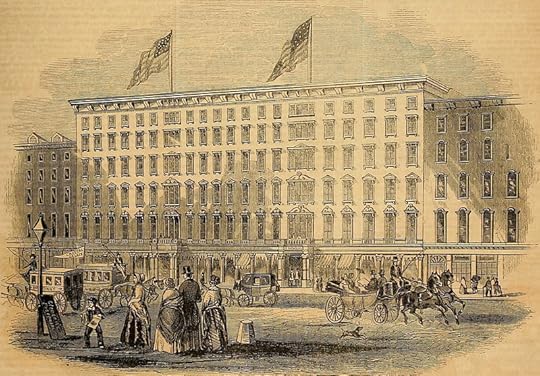 The St. Nicholas Hotel, 1853.
The St. Nicholas Hotel, 1853.Meanwhile, as the city surged uptown, the six-story, 600-room St. Nicholas Hotel opened on Broadway at Broome Street in 1853. A massive structure with a gleaming white marble façade, it offered the innovation of warm air circulating through registers to every room – a luxury that even the Astor House couldn’t offer. Other attractions included walnut wainscoting, frescoed ceilings, gas-lit chandeliers, hot running water, a telegraph in the lobby, a bridal room with four chandeliers and a canopied bed upholstered in white satin, and steam-powered washing machines in the basement. There were opulent parlors for ladies and gentlemen, a sumptuous reading room, and a stately second-floor dining room where liveried Irish servants escorted guests to their seats. And on Broadway right next to the hotel’s main entrance was Phalon’s Hair-Dressing Establishment where, under a frescoed ceiling with an ornate domed skylight, gentlemen could be trimmed, shaved, and groomed with fragrant oils and greases and pale rum in an atmosphere that observers likened to the palace of an Eastern potentate.

The St. Nicholas seemed the very last word in luxury and sumptuous technology, yet it too was destined to be eclipsed, for in 1859 the Fifth Avenue Hotel opened at Fifth Avenue between 23rdand 24th streets, opposite Madison Square. A magnificent six-story building of brick faced with white marble, it had the breathtaking novelty of a “vertical screw railway,” the first passenger elevator installed in a hotel in the United States, a cumbersome affair powered by a stationary steam engine that – to the astonishment and wonder of all – could carry passengers to the upper floors. The hotel’s sober Italianate exterior masked a number of ground-floor public rooms that were richly furnished with gilt wood, crimson or green curtains, and costly carpets. Four hundred servants looked after the guests, who enjoyed private bathrooms and a fireplace in every room.
 The Fifth Avenue Hotel, 1859.
The Fifth Avenue Hotel, 1859.An instant success, the hotel’s reading room was soon filled with gentlemen scanning newspapers, its dining room was jammed with diners, and certain ground-floor rooms became the preferred evening gathering place for Wall Street brokers and speculators after the stock exchange had closed. Hotel guests marveled at the jabbering throng trading tips and rumors, and marveled even more when the throng suddenly fell silent and parted, making way for the august and towering presence of Cornelius Vanderbilt, endearingly known in the 1860s as “Old Sixty Millions,” the richest man in the country, whose prospering railroad empire would earn him, by the 1870s, the name of “Old Eighty Millions.”
It should now be clear that each of the nineteenth-century palace hotels endeavored to outdo its predecessors in offering guests the latest in comfort, luxury, and technological advances, and that they were more than just sanctuaries where weary travelers could lay their weary but dazzled heads. They were also social centers, dining establishments, and even, on occasion, political headquarters where party members or their bosses met to make significant decisions regarding upcoming elections.
New York then and now has had too many hotels of every rank, from the palatial to the most modest and budget-prone, for me to list them here. So I’ll focus on those that have something special going for them, something that gives them an aura of distinction and prestige.
The Plaza Hotel at 59th Street and Fifth Avenue, at the southeastern corner of Central Park and overlooking Grand Army Plaza, is a massive 20-story French Renaissance chateau-style edifice built in 1907 and a National Historic Landmark since 1986. Kings, presidents, ambassadors, celebrities, CEOs, and world travelers have stayed there over the years, not to mention the Duke and Duchess of Windsor, and the Beatles on their first trip to the U.S. in February 1964. The sedate Plaza was dismayed to learn that the rooms reserved for “four English gentlemen” were meant for the Beatles, and were further dismayed by the screaming fans, mostly teen-age females, who, once the Beatles had arrived, created pandemonium outside. The foursome’s return to England inspired in the hotel a deep sigh of relief, and they were glad to let other hotels host the rock band on their later visits to the city.
 The Plaza Hotel today.
The Plaza Hotel today.Yarl
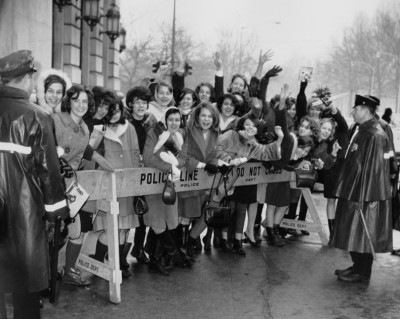 What the Plaza was unhappy about in 1964. When I came to New York I often heard mention of “the Oak Room at the Plaza” and finally, at a friend’s prompting, visited this storied restaurant and adjoining bar, which had been serving men-only lunches since the hotel’s opening, until Betty Friedan and the National Organization for Women staged a protest there in 1969. The Oak Room was a grand, opulent, and elegant space frequented by the rich and famous, even though my friend and I managed to get in. I vaguely recall it as having a rather warm and woody atmosphere, supremely stylish and tasteful. So it’s dismaying to learn that it was closed in 2011, because the brunch parties staged there had become noisy and rowdy, annoying the Plaza’s long-term tenants. The participants in these orgies were said to indulge in drugs and loud music and Lady Gaga, while spraying each other with champagne. Lady Gaga’s flamboyant presence, wearing a wild blond wig, fishnet tights, and a dress made of honey-colored hair, would be enough to demolish instantly the aura of taste and elegance of any once legendary hostelry. A sad comedown, perhaps, for a once elegant locale, and a reminder that in a city like New York things can change, and not always for the better.
What the Plaza was unhappy about in 1964. When I came to New York I often heard mention of “the Oak Room at the Plaza” and finally, at a friend’s prompting, visited this storied restaurant and adjoining bar, which had been serving men-only lunches since the hotel’s opening, until Betty Friedan and the National Organization for Women staged a protest there in 1969. The Oak Room was a grand, opulent, and elegant space frequented by the rich and famous, even though my friend and I managed to get in. I vaguely recall it as having a rather warm and woody atmosphere, supremely stylish and tasteful. So it’s dismaying to learn that it was closed in 2011, because the brunch parties staged there had become noisy and rowdy, annoying the Plaza’s long-term tenants. The participants in these orgies were said to indulge in drugs and loud music and Lady Gaga, while spraying each other with champagne. Lady Gaga’s flamboyant presence, wearing a wild blond wig, fishnet tights, and a dress made of honey-colored hair, would be enough to demolish instantly the aura of taste and elegance of any once legendary hostelry. A sad comedown, perhaps, for a once elegant locale, and a reminder that in a city like New York things can change, and not always for the better. The Plaza has had a series of owners and is now owned by Sahara India Pariwar, an Indian conglomerate that is currently trying to sell it. Though today it claims to strike a balance between a storied past and a limitless future, one wonders if its glory days are long since past. But there’s hope: it claims to be the first hotel in the world to offer iPads for all guests, allowing them, with the touch of a screen, to order in-room meals, communicate with the Concierge, request wake-up calls, and check airline schedules and print boarding passes. But it can’t get them into the legendary Oak Room, which has ceased to exist.
Only one other New York hotel enjoys the status of National Historic Landmark: the looming 47-story Waldorf Astoria, the second of that name, occupying the entire block between Lexington and Park avenues and between 49th and 50th streets, a massive limestone structure in what is described as “restrained Art Deco style” that opened in 1931. With twin towers topped by bronze-clad cupolas rising above the twenty floors of the main building, its great mass has a majesty all its own; it overwhelms. The 1413 guest rooms include 181 in the Waldorf Towers, a hotel within a hotel occupying floors 27 through 42, and of those 181 there are 121 luxury suites often named for eminent guests who once resided there: the Presidential Suite, the Elizabeth Taylor Suite, etc. Those guests have included ex-president Herbert Hoover, who lived there for over 30 years, Cole Porter, Douglas MacArthur, Prince Rainier and Princess Grace of Monaco, society hostess and party-giver Elsa Maxwell (who got a rent-free suite, in hopes she would lure the affluent), and Bugsy Siegel and Lucky Luciano.
 The Waldorf Astoria as seen from the north, with St. Bartholomew's Church.
The Waldorf Astoria as seen from the north, with St. Bartholomew's Church.Reading Tom
Wait a minute – Bugsy Siegel and Lucky Luciano, two notorious mobsters, at the Waldorf? Treading the same corridors as an ex-president and the Duke and Duchess of Windsor? Is this conceivable? Yes, it is. Thanks to prohibition and America’s craving for liquor, Bugsy Siegel by 1927, at the tender age of 21, was awash in cash and, to flaunt it, bought an apartment at the Waldorf. We’ll assume that management didn’t know who they were dealing with, and of course his money was good. The same goes for Charles “Lucky” Luciano, who in the early 1930s lived in room 39D in the luxurious Waldorf Towers under the name Charles Ross, and looked very much the affluent businessman, wearing custom-made suits and riding about in a chauffeur-driven limousine. He held meetings of the mob in his suite and was even photographed there with some of his cohorts. In 1936, when U.S. Attorney Thomas Dewey tried him for operating a massive prostitution ring, the testimony of Waldorf employees about him and his associates at the Waldorf was devastating to his defense and helped bring about his conviction. (More of this in a forthcoming post.) And in his later years yet another gangster, Frank Costello, got his haircut and manicure regularly at the hotel’s barber shop.
Another eminent guest was General Douglas MacArthur who, returning to this country in 1951, was lodged with his second wife and their only child in a suite in the Waldorf Towers. So it was from this exclusive address that his son Arthur MacArthur issued daily to attend classes at Columbia College, where he was in the second-year French class that I was teaching in 1957. A sensitive 19-year-old with an excellent accent in French that must have been acquired through private tutoring, he sat apart from the other male students. Remembering photos of him at a very young age with his mother and his Chinese amah in Australia, where they went following their escape with the General from the besieged Philippines in 1942, I sensed that, through no fault of his own, he had been too much in the company of women and needed more contact with boys his own age. His parents resided at the Waldorf from 1952 until 1964, the year of the General’s death, and his mother continued there until her death.
(A brief digression regarding Arthur MacArthur: With his father in charge of the war in the South Pacific, at age 4 his photo had appeared on the cover of the Life magazine of August 3, 1942, and prior to that he had been photographed repeatedly with his father. After the General’s death in 1964 he moved out of the Waldorf to another part of Manhattan and changed his name, so as to creep out from under the burden of an illustrious heritage. His father had wanted him to go to West Point, but he was drawn to music, literature, the arts, and theater. For decades he simply vanished from sight, probably glad to escape the publicity that, as a son and grandson of renowned generals, had so oppressed him and kept him from living a life of his own. Then, just last year, it was reported that Arthur MacArthur, who would now be 76, was one of four reclusive tenants in rent-controlled apartments in the Mayflower Hotel on Central Park West who were given lavish sums by a developer to move out. Arthur MacArthur is said to be living now in Greenwich Village, which, if true, makes him a neighbor of mine. I wish him well in his anonymity.)
Lavish dinners, business conferences, and fund-raising galas have been held at the Waldorf. Prominent among them was the annual April in Paris Ball (later moved to October), which, in the words of an organizer, catered to “very, very high-class people” and raffled off prizes like a chinchilla coat, a Ford Thunderbird car, 25 cases of expensive French wines, a pedigree poodle, and other goodies, with earnings going to French and American charities. Unique among hotels, it also became involved in world affairs, hosting international conferences and secret meetings of statesmen and other figures of prominence, and receiving controversial foreign leaders requiring the highest level of security.
 Society hostess Elsa Maxwell whispering to Marilyn Monroe at the April in Paris Ball,
Society hostess Elsa Maxwell whispering to Marilyn Monroe at the April in Paris Ball, 1957. There's a story here; it will be told in a future post. A 1949 conference, held at the Waldorf to discuss the emerging the Cold War in hopes of promoting peace, was attended by Soviet Foreign Minister Andrey Vyshinsky, composer Dmitri Shostakovich, Albert Einstein, and others, but was climaxed by Shostakovich’s outburst in front of 800 people asserting that “a small clique of hatemongers are preparing world public opinion for the transition from cold war to outright aggression.” Anti-Stalinist activists picketed outside, flaunting signs saying NIET TOVARICH! (no comrade!) and SHOSTAKOVICH! JUMP THRU THE WINDOW, while prominent American literary figures denounced Stalinism inside. Needless to say, the Cold War continued unabated.
An international event of somewhat less significance was the stay there of the British rock band The Who in 1968, when a dispute with the hotel staff led to their being denied access to their room. What prompted the Waldorf to receive a band known for rowdy behavior and trashing hotel rooms is unclear, but the band’s response was forthright and immediate: they blew the locked door off its hinges with a cherry bomb and retrieved their luggage, following which they were banned from the hotel for life – a ban later revoked when The Who were inducted into the Rock and Roll Hall of Fame in a ceremony held at the Waldorf in 1990.
Though not a “very high-class people,” back in my freelance editing days I used to obtrude my plebeian presence on this storied edifice. Coming back from a publisher on Third Avenue, I would enter the Waldorf on Lexington Avenue and walk the length of the arcade, lined with pricey boutiques, that leads to the elegant Park Avenue lobby. There I would usually linger for a few moments, enjoying the music from the plucked strings of a harp on a mezzanine above. Most of the people traversing the lobby seemed totally unaware of the music and hurried on, but I and a few others savored it, grateful for the surprising presence of the woman harpist who sent these gentle sounds wafting down to us below. A harpist lodged above a hotel lobby: once again, the Waldorf was unique.
 The Waldorf lobby. All this and harp music, too.
The Waldorf lobby. All this and harp music, too.Alan Light
And who owns the Waldorf today? From 1972 on, Conrad Hilton, but as of October 2014, the Anbang Insurance Group of China, who acquired it for $1.95 billion, the highest price ever paid for a hotel. So the legendary Waldorf Astoria, like the Plaza, is foreign-owned today.
Note on J.P. Morgan: Once again I must come to the defense of J.P. Morgan Chase, my beloved candy-dispensing bank, whom the government just won’t let alone. Targeted by an anti-trust lawsuit accusing 12 major banks of rigging prices in the foreign-exchange market, it has agreed to pay $99.5 million to settle its portion of the suit. And this on top of a $1 billion settlement to resolve claims by U.S. and European regulators last November! To top it off, the New York Times article reporting the latest settlement reads as follows:
JPMorganTo Pay Out$99 MillionOver Graft
Not only is this unsporting of the Times, to hit a man when he’s down, but referring to the matter as “graft” is worthy of the lowest, meanest, nastiest, most sensationalist tabloid. Let the Newspaper of Record take note: It wasn’t graft, it was profit enhancement.
Notes on Al Sharpton and friends:
1. A viewer of this blog informs me that Al Sharpton may have had surgery to reduce his girth. He denies it, but some medical sources confirm it. (See last week’s post #164 on Al Sharpton.)
2. Another viewer of this blog informs me that, back during the Tawana Brawley controversy, he heard attorneys Alton H. Maddox and C. Vernon Mason tell a WNYC interviewer that Attorney Steven Pagones was in the habit of taking out photos of Tawana and “massabatin.” At first he wondered if he heard this remark right, but when the station did an end-of-the-year roundup of the big stories of the year, he heard the remark repeated. Both attorneys, he further informs me, have since been disbarred.
Coming soon: More on great hotels: the hotel that hosted the “Vicious Circle”; the hotel whose manager terrorized the staff; budget hotels; the super modern hotel that to my eye looks clunky; and the hotel where you shouldn’t attempt suicide, and why. Also: How did Franklin Delano Roosevelt get to his Waldorf suite without being seen by the public? And what is the weirdest request ever made by a guest at the Waldorf Towers, and what did the Waldorf do about it?
© 2015 Clifford Browder
Published on February 08, 2015 04:32
February 1, 2015
164. Al Sharpton: Rabble Rouser or Champion of His People?
New Yorkers have to face the dismaying fact that their mayor, Bill de Blasio, and their police force are at loggerheads. At the recent funerals of two policemen shot in their patrol car and killed by a black assailant who then committed suicide, many of New York’s Finest turned their backs on the Mayor when he spoke. And the president of the Patrolmen’s Benevolent Association asserted at a press conference that the Mayor, having incited violence on the streets in the guise of protest over the recent police killing of an unarmed black man on Staten Island, had blood on his hands. The grievances of New York’s Finest against the Mayor are many, among them his warning to his biracial son to be careful during police encounters. But what they especially resent are his public appearances with the Reverend Al Sharpton, who is, and for many years has been, one of the most controversial public figures in the city. So who is Al Sharpton?
Al Sharpton is a Brooklyn-born African-American civil rights activist who has led many protest marches and demonstrations challenging the white power structure on behalf of African Americans. He is also a Baptist minister, a talk show host, and a White House adviser consulted by President Barack Obama, who has called him “the voice of the voiceless and a champion of the downtrodden.” But he has also been called an inflammatory black radical, a demagogue, a rabble rouser, a fraud, and much more, and his career has been marked by controversy.
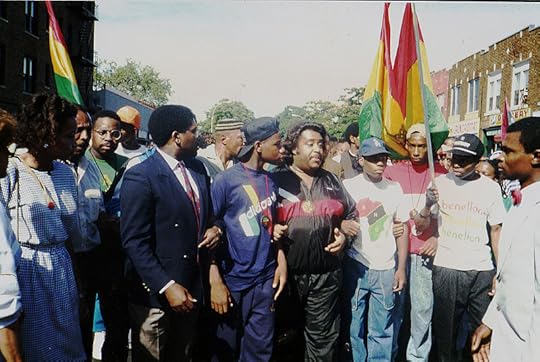 Al Sharpton (center) leading a march in Bensonhurst in 1989.
Al Sharpton (center) leading a march in Bensonhurst in 1989.christian razukas
It was his eagerness to lead protest marches and demonstrations on behalf of African Americans, often with shouts of “No justice, no peace,” that first vaulted him into fame ... or notoriety. Indeed, what controversy involving race and racism in this city has he not been involved in, often in a track suit, obviously overweight, his dark hair down to his shoulders, with a thin black mustache curled snakelike over his upper lip. Examples of his activism include:
· Marches protesting the outcome of the trial of Bernhard Goetz, a white man who shot four young African Americans on a subway train in 1984 – a case that electrified and divided the crime-ridden city. Goetz was cleared of all charges except carrying an unlicensed firearm. A federal investigation concluded that the shooting was the result of an attempted robbery, not racism.· A march of 1200 demonstrators through Howard Beach, a mostly white neighborhood in Queens, following the assault there in 1986 of three African Americans by a mob of white men, resulting in the death of one of the victims who, when fleeing, was hit by a passing motorist. During the march the white residents screamed racial insults at the black marchers.· Marches through Bensonhurst, Brooklyn, to protest the attack on four African-American teenagers by a mob of white Italian-American youths in 1989, during which one of those attacked was shot and killed. Residents shouted “Niggers go home!” at the marching protesters and would have assaulted them, had the police not intervened. In 1991 the attackers received light sentences, and when Sharpton prepared to lead another protest march, a neighborhood resident stabbed him in the chest. Sharpton recovered and asked the judge for leniency when his assailant was sentenced, but sued the city, alleging that the police had failed to protect him, and got a settlement of $200,000.· A march in 1991 through Crown Heights, Brooklyn, where West Indians and African Americans live in perilous proximity with Hasidic Jews. Four days of race riots erupted following the accidental killing of a seven-year-old Guyanese boy, when a car driven by a Jew was struck by another vehicle and forced onto the sidewalk. Black youths looted stores and beat Jews in the street, and a visiting Jewish student from Australia was stabbed and killed, while rioters chanted “Kill the Jew!” and “Get the Jews out!” Sharpton’s march, on the third day of riots, had a distinctly anti-Semitic tone.· A 1999 protest over the death of Amadou Diallo, an unarmed immigrant from Guinea shot to death by police officers who thought he was drawing a gun. Diallo’s family later got $3 million in a wrongful death suit filed against the city.· Peaceful protests in 2008 when three detectives were found not guilty in the shooting of Sean Bell in a hail of 50 bullets on the morning of his wedding in 2006. Bell had been accosted by detectives outside a strip club in Queens, and was allegedly trying to flee in his car when he was shot. The protests blocked traffic at bridges and tunnels giving access to the city, and Sharpton and 200 others were arrested.· Peaceful protests on Staten Island, the city’s whitest borough, in July and August 2014, following the death of Eric Garner when an officer put him in a chokehold, a strangling hold that is prohibited. Garner was evidently selling illegal cigarettes and may have resisted arrest. Captured on video, his repeated cry of “I can’t breathe!” became a rallying cry of protesters. His death was ruled a homicide, but on December 3, 2014, a grand jury decided not to indict the officer who had administered the chokehold, prompting protests nationwide. When two police officers were shot and killed in their patrol car on December 20, the assailant, who then committed suicide, was motivated by two recent police shootings: Michael Brown in Ferguson, Missouri, and Eric Garner on Staten Island.
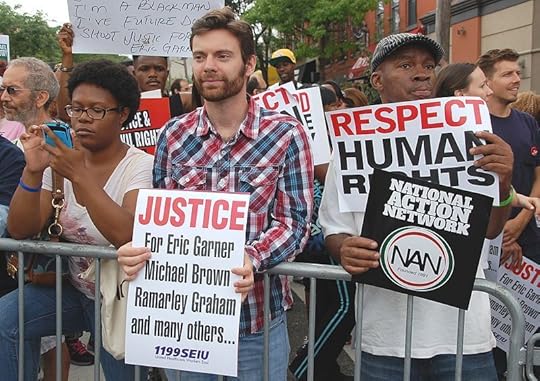 Protesters at a rally called by Sharpton in August 2014 to protest the death of Eric Garner and others.
Protesters at a rally called by Sharpton in August 2014 to protest the death of Eric Garner and others.Thomas Altfather Good And these are only some of the protests Al Sharpton has been involved in. Former mayor Ed Koch, once a foe of Sharpton’s, has said that Sharpton deserves the respect he enjoys among African Americans: “He is willing to go to jail for them, and he is there when they need him.” So why is he so controversial? Recently, when I mentioned Sharpton by name to two friends with long memories, both immediately said, “Tawana Brawley.” Yes, Sharpton’s name is irrevocably linked to that of Tawana Brawley, and this explains much of the feeling against him. So who is – or was – Tawana Brawley?
 Tawana Brawley at a press conference. Tawana Brawley was a 15-year-old African American who had been missing from her home in Wappinger Falls, New York, for four days when, on November 28, 1987, she was found lying in a garbage bag and smeared with feces, her clothing torn and burned, and with “KKK,” “nigger,” and “bitch” written on her body with charcoal. Interrogated at the hospital, she was verbally uncommunicative, but through gestures and writing claimed that she had been assaulted and raped by three white men, at least one of them a police officer. She gave no names or descriptions of her attackers, and forensic tests found no evidence of a sexual assault, nor was there any evidence of exposure to elements such as would have occurred in a victim held for several days in the woods.
Tawana Brawley at a press conference. Tawana Brawley was a 15-year-old African American who had been missing from her home in Wappinger Falls, New York, for four days when, on November 28, 1987, she was found lying in a garbage bag and smeared with feces, her clothing torn and burned, and with “KKK,” “nigger,” and “bitch” written on her body with charcoal. Interrogated at the hospital, she was verbally uncommunicative, but through gestures and writing claimed that she had been assaulted and raped by three white men, at least one of them a police officer. She gave no names or descriptions of her attackers, and forensic tests found no evidence of a sexual assault, nor was there any evidence of exposure to elements such as would have occurred in a victim held for several days in the woods.Tawana Brawley’s story captured headlines nationwide and aroused great shock and sympathy, and money was raised for a legal fund. Al Sharpton and black attorneys Alton H. Maddox and C. Vernon Mason joined forces to champion her cause, which became a media sensation. The trio of activists claimed that officials all the way up to the government in Albany were trying to protect the white attackers, and named Steven Pagones, an Assistant District Attorney in Dutchess County, as one of the rapists.
The case went to a grand jury that heard 180 witnesses and saw 250 exhibits, and then on October 6, 1988, released a 170-page report noting many discrepancies in her story and citing “overwhelming evidence” that Brawley had not been abducted, assaulted, and raped, and that the allegations against Pagones were false. But why would she have concocted such a story? Based on the testimony of witnesses, she might have done it to avoid violent punishment from her mother and stepfather, who had abused her in the past.
Steven Pagones sued Brawley’s three advisers for defamation of character and in 1998 was awarded $345,000. He also sued Brawley, who did not appear at the trial and was ordered to pay Pagones $186,000. Just where she was supposed to get such a sum wasn’t clear, but in 2013 – yes, the case’s aftermath lasted that long -- a court ordered her wages garnished. Sharpton failed to pay the sum required, claiming he lacked the funds, but his supporters paid it in 2001.
Sharpton never recanted, and to this day Brawley, her mother, and her stepfather insist that the attack did indeed take place. Brawley herself now lives in Virginia under an assumed name and works there as a nurse. White people doubted her story from the outset, but there are still blacks who believe it. My own take on the affair is this: a rebellious but frightened teenager, having been absent from home for four days and fearing more abuse at home, invented a wild story to bring her sympathy, having no idea what the consequences might be; having lied, she had to stick to her lies through thick and thin. As for Sharpton, his vigorous defense of her shows a grievous lack of judgment, one that his many critics will never fail to cite.
A curious twist in Sharpton’s story came to light when he admitted to having informed for the government in the 1980s, so as to stem the flow of crack cocaine into black neighborhoods. But he denied having ever informed on black civil rights leaders. More detailed reports have since emerged of Sharpton’s working as a paid informant for the FBI, helping the government bring charges against the mobsters flooding the ghettos with drugs.
In 2009 Sharpton became an honorary member of Phi Beta Sigma, an African American Greek-letter fraternity whose mission is to promote brotherhood, scholarship, and service. Members have included foreign heads of state, scientists, musicians, athletes, and activists, a feisty mix of notables ranging from George Washington Carver, Harry Belafonte, and ex-President Bill Clinton to Black Panther Party founders Huey Newton and Bobby Seale.
Sharpton’s name has a way of popping up often in the news, but not always as a champion of his people. In 2005 he agreed to repay $100,000 in public funds he had received from the federal government for an unsuccessful Presidential campaign in 2004. And in 2008 it came to light that he and his businesses owed close to $1.5 million in unpaid taxes and penalties. It was also reported that several major corporations had donated large sums to Sharpton’s National Action Network, an organization founded by him to increase voter education, provide services to the poor, and support community small businesses. The donations were allegedly made to avoid boycotts or rallies against them, which Sharpton has vigorously denied. And as of November 2014 Sharpton and his businesses reportedly owed $4.5 million in state and federal taxes. To put it mildly, his finances are a mess.
He is still addressed as Reverend, though he has obviously spent more time in the streets than in the pulpit. Yet he is said to have preached his first sermon at the age of four (what pearls of wisdom must have issued from his lips!), and he was licensed to be a minister at nine. Yet for all his commitment to politics, he still preaches in the U.S. and abroad, and insists that his religious convictions are the basis for his life.
Sharpton has evolved from agitator to insider, being consulted by Barack Obama’s White House in the wake of the police shooting of Michael Brown, an unarmed black man, in Ferguson, Missouri, on August 9, 2014, following which the local black community exploded into protests that were sometimes violent. Obama needed a spokesman with credibility in the black community, both in Ferguson and nationally, and Sharpton was the guy. Which doesn’t sit well with former mayor Rudy Giuliani, who has asserted on TV that the President’s association with Sharpton proves that he’s against the police. “He has had Al Sharpton to the White House 85 times. Often when he’s talking about police issues he has Al Sharpton sitting next to him.”
But is the Sharpton of today the same as the Sharpton of the marches and protests, a Sharpton noted for his fiery rhetoric? “I’ve grown to appreciate different roles and different people,” Sharpton told an interviewer recently, “and I weigh words a little more now. I’ve learned to measure what I say.” And he’s shed 150 pounds, giving the new Al Sharpton a slimmer look further enhanced by his appearing in a tailored suit, his gray hair neatly trimmed; in fact, he looks like he belongs not on the streets but in a boardroom. When he encounters criticism from some in the black community for playing the role of “house negro,” he dismisses such comments as irrelevant. Now sixty, he is hailed as a civil rights icon by New York Mayor Bill de Blasio, New York Governor Andrew Cuomo, and the President – a heady experience for the street agitator of yore.
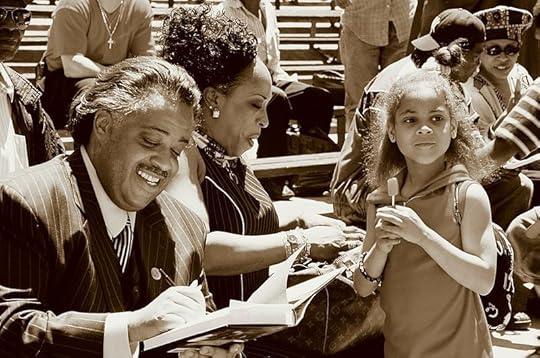 Sharpton signing a book in 2008. Note the pin-striped suit and the flashy tie.
Sharpton signing a book in 2008. Note the pin-striped suit and the flashy tie.Azim thomas
So how are Mayor de Blasio and the Reverend Sharpton getting along today, given the sharp criticism of the Mayor by the police, who are vehemently critical of Sharpton? On January 20, for the first time since the killing of the two police officers and the controversy that followed, the mayor and Sharpton found themselves appearing together at an annual event celebrating Martin Luther King’s birthday sponsored by Sharpton’s National Action Network in Harlem. Speaking at a podium bearing the words NO JUSTICE NO PEACE, de Blasio advocated respect for the police: “If you’re saying something vicious and vile to a police officer, you’re not making change.” And Sharpton praised him for showing grace and dignity in the face of “venomous, unfair stuff” in the last few weeks, and it’s obvious whose “stuff” he’s referring to. But he also insisted that he and his community are not anti-police.
Will this joint plea for civility damp down the police’s sharp criticism of the Mayor? Don’t count on it. And what do I think of the slim and trim Al Sharpton of today, tailored suits and all? Like Ed Koch, I have to admit, albeit gudgingly, that he’s always been there for his people, even risking his life. I just wish he would pay his taxes.
 Sharpton in 2007.
Sharpton in 2007.David Shankbone
Notes from viewers on BIG: Two viewers have given me interesting comments on post #162.5, which discussed Jamie Dimon, CEO of JP Morgan Chase, and a possible real estate bubble in the city.
· One, a resident of the Upper East Side, says that she met Jamie Dimon once at a book party at his apartment when he first became head of Chase. She found him “totally unimpressive” and not as handsome as in his photos. This surprises me, since those photos show a good-looking older man, immaculately groomed, who looks like he’s in command of the world.
· The other viewer, a resident of Jersey City, reports that Mayor Fulop has BIG plans for development around Journal Square, namely a 95-story residential tower that will help give the city a “world-class skyline” and be the tallest building in the state. Jersey City is now experiencing the greatest construction boom in its history, thanks to Mayor Fulop, according to Mayor Fulop. Currently the tallest building in the state is the Goldman Sachs tower (there they are again -- see post #158!), also on Journal Square. Personally, I can’t complain about such construction, since my memories of some years back register Journal Square as the most uninspired hodgepodge of a square that I ever had the misfortune to behold. So hurrah for this drastic change; Journal Square can use a facelift. But does this quest of BIG BIGGER BIGGEST suggest a bubble over there too? Time will tell.
· The resident of Jersey City also informs me that the current administration of the city of Paris is working with architects and developers to bring “innovative architecture” to the city, which means three new high rises on the city’s periphery, controversial renovations of landmark locations, and a competition for 23 city-owned sites. So where is Paris heading? Acclaimed by many as the most beautiful city in the world, Paris, unlike Jersey City, has a lot to lose. This crisis – for I would term it such – is of concern to a newly created organization, Americans for the Preservation of Paris. Jersey City belongs to Jersey City, but Paris belongs to the world.
Coming soon: Great Hotels of the Past and Present. Which hotel was the first to install a “vertical screw railway,” which we today would call an elevator? Which one hosted the Beatles in 1964 and vowed never to do so again? Which one housed not only an ex-President and the Duke and Duchess of Windsor, but also mobsters Bugsy Siegel and Lucky Luciano? Which one locked The Who out of their room, prompting the British rock group to blast the door open with a cherry bomb, so they could get their luggage? And which one is the current favorite for would-be suicides, and why is that a mistake? Never a dull moment in the great hotels of New York.
© 2015 Clifford Browder
Published on February 01, 2015 04:44
January 25, 2015
163. Son of Sam
At about 1:10 a.m. on the night of July 29, 1976, Donna Lauria, a young woman of 18, was sitting with her friend Jody Valenti, 19, in Valenti’s parked car in the Pelham Bay area of the Bronx, talking about their night at a discotheque. When she opened the car door to leave, she saw a man rapidly approaching. The look of anger on his face alarmed her, but before she could do anything, he took a handgun out of a paper sack, crouched, braced one elbow on his knee, aimed his weapon with both hands, and fired. One bullet hit Lauria and killed her instantly; a second hit Valenti in the thighs; a third missed. The attacker, having spoken not a single word, then quickly walked away.
Jody Valenti survived the attack and described the killer as a white male in his 30s with short, dark, curly hair and a fair complexion, about 5 feet 9 inches tall, and weighing about 160 pounds. Neighbors reported seeing an unfamiliar yellow compact car cruising in the area for hours prior to the attack. Ballistics tests identified the murder weapon as a Charter Arms .44 caliber Bulldog model, a five-shot revolver meant for use in close quarters. The police speculated that the murderer might be a spurned suitor of Lauria, or, since the neighborhood had recently witnessed mob activity, that the shooting was a case of mistaken identity.
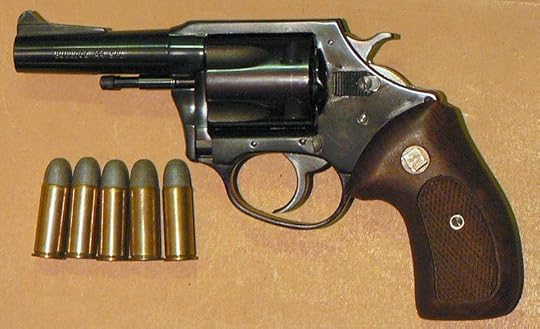 A Charter Arms Bulldog
A Charter Arms BulldogM62
On the night of October 23, 1976, Carl Denaro, 25, and Rosemary Keenan, 28, were sitting in Denaro’s parked car in the Flushing neighborhood of Queens, when the car windows were suddenly shattered. Denaro quickly started the car and sped off for help, unaware that he was bleeding from a bullet wound in the head; Keenan had only superficial wounds from the broken glass. Neither had seen the attacker.
The police determined that the bullets embedded in the car were .44 caliber, but too damaged to be linked to a particular weapon. There was no apparent motive for the crime, nor was it linked to the previous shooting in another borough. They later noted that Denaro had shoulder-length hair and might have been mistaken for a girl.
Shortly after midnight on November 27, 1976, Donna DeMasi, 16, and her friend Joanne Lomino, having walked home from a movie, were chatting on the porch of Lomino’s home on a quiet residential street in the Bellerose section of Queens, when a man in military fatigues approached and in a high-pitched voice began to ask for directions. But then he whipped out a revolver, shot each girl once and, as they fell to the ground, fired several more shots that struck the apartment building before he ran away. Hearing the shots, a neighbor rushed out and saw a blond man rush by, a pistol in his left hand.
DeMasi had a shot in her neck but survived. Hit in the back, Lomino was hospitalized in serious condition and became a paraplegic. The police produced several composite sketches of the blond shooter based on the descriptions given by the victims and their neighbor. Once again, the bullets were .44 caliber but too deformed to be linked to a particular weapon.
Early in the morning of January 30, 1977, an engaged couple, Christine Freund, 26, and John Diel, 30, were sitting in Diel’s car in the Forest Hills section of Queens; having seen a movie, they were planning to go to a dance hall. Suddenly three gunshots ripped into the car. Terrified, Diel drove away for help. He had only superficial wounds, but Freund had been shot twice and died several hours later in a hospital. Neither had seen their assailant.
The police now acknowledged that this crime resembled the earlier shootings and might be the work of the same attacker. All the victims had been shot with .44 caliber bullets, and young women with long, dark hair seemed to be the preferred victims. Composite sketches of the black-haired Lauria-Valenti attacker and the blond Lomino-DeMasi attacker were released to the public, with word that the police were looking for not one but multiple suspects.
At around 7:30 p.m. on March 8, 1977, Barnard College student Virginia Voskerichian, 19, was walking home on a quiet street in Forest Hills, Queens, only a block away from where Christine Freund had been shot. Suddenly she was confronted by an armed man. In desperation she placed her textbooks between her and the man, but he fired a shot that went right through them, struck her head, and killed her.
No one had witnessed the murder, but a neighbor reported seeing a chubby teenager sprinting away from the scene. Others reported seeing both a teenager and an older man loitering separately in the area an hour before the shooting. The media repeated police claims that a “chubby teenager” was the suspect. This crime differed from the preceding incidents, in that the other victims were couples and were shot on weekends.
By now it was clear: a serial killer was on the loose. At a press conference on March 10, police officials and Mayor Abe Beame announced that the same .44 caliber revolver had killed Lauria and Voskerichian. That same day saw the launching of the 50-man Operation Omega task force, charged solely with investigating the .44 caliber murders, with Deputy Inspector Timothy Joseph Dowd in charge. Baffled by the lack of an obvious motive, the police speculated that the killer had a vendetta against women, possibly resulting from social rejection, but viewed the “chubby teenager” as a witness and not a suspect in the Voskerichian murder.
A task force of 50 officers to track down a single killer: this case had assumed major proportions. The New York area media discussed it daily, and the world press carried many of the reports. For the city, burdened already with a high crime rate and a mounting fiscal crisis, word of a serial killer seemed to dramatize a city in desperate straits. Newly established in our apartment, my partner Bob and I had window gates guarding all the windows, and a police lock on the door, and Bob, returning home one night from the opera, narrowly escaped being mugged in the vestibule downstairs. But for us in Manhattan, the .44 caliber killer off in the outer boroughs seemed remote.
Early in the morning of April 17, 1977, Alexander Esau, 20, and Valentina Suriani, 18, were sitting in Esau’s parked car near her home in the Baychester section of the Bronx, but a few blocks from the scene of the Lauria-Valenti shooting. Suddenly, about 3:00 a.m., another car pulled up beside them, shots rang out, and each of them was wounded twice. Suriani died on the scene, and Esau died several hours later in the hospital without being able to describe the assailant.
This crime was obviously similar to preceding ones, and the police declared that the .44 caliber weapon involved was the same as in the earlier attacks. They continued to assume that the chubby teenager of the Voskerichian case was only a witness, the suspect being the dark-haired man of the Lauria-Valenti case.
What the police didn’t tell the public was that a lengthy handwritten letter had been left by the killer at the site of this attack. Written mostly in capital letters, the rambling letter was addressed to Captain Joseph Borelli of the task force and began by protesting that the killer was not a “wemon hater” but a monster, the “Son of Sam.” Father Sam, it explained, abused him when drunk and ordered him to “Go out and kill.” “To stop me you must kill me,” the writer insisted. “I love to hunt,” he added; prowling the streets, he looked for “fair game.” “Blood for papa.” He ended by wishing everyone a Happy Easter, then added these words:
I SAY GOODBYE AND GOODNIGHT.POLICE: LET MEHAUNT YOU WITH THESEWORDS;I’LL BE BACK!I’LL BE BACK!TO BE INTERRPRETEDAS – BANG BANG BANG,BANK, BANG – UGH!! YOURS IN MURDER MR. MONSTER
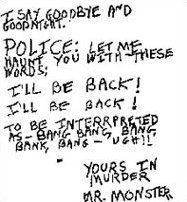 Selections from the letter were soon leaked to the press, and the .44 caliber killer was quickly rechristened “Son of Sam.” The case was now receiving frenzied attention, being reported worldwide. The New York Post, recently acquired by Rupert Murdoch, offered sensationalist coverage, but the story appeared also in the Vatican’s L’Osservatore Romano, the Israeli Hebrew-language newspaper Maariv, and the Soviet Izvestia, which probably cited it as further evidence of the decadence of capitalism. Son of Sam was known worldwide, and his warning “I’ll be back!” haunted everyone.
Selections from the letter were soon leaked to the press, and the .44 caliber killer was quickly rechristened “Son of Sam.” The case was now receiving frenzied attention, being reported worldwide. The New York Post, recently acquired by Rupert Murdoch, offered sensationalist coverage, but the story appeared also in the Vatican’s L’Osservatore Romano, the Israeli Hebrew-language newspaper Maariv, and the Soviet Izvestia, which probably cited it as further evidence of the decadence of capitalism. Son of Sam was known worldwide, and his warning “I’ll be back!” haunted everyone.Psychologists who were consulted explained that serial killers derive great satisfaction from manipulating their pursuers and exercising control over the media, the police, and the population generally. The police then released a psychological portrait of the suspect, describing him as a neurotic probably suffering from paranoid schizophrenia and believing himself to be a victim of demonic possession.
On May 30, 1977, Daily News columnist Jimmy Breslin, who had written about the case, received a handwritten letter from someone claiming to be the .44 shooter. Neatly printed on the back of the envelope were the words
Blood and FamilyDarkness and DeathAbsolute Depravity.44
The letter inside said “Hello from the gutters of N.Y.C. which are filled with dog manure, vomit, stale wine, urine and blood,” then went on to inform “J.B.” that he appreciated his interest in the killings, but that Sam was a thirsty lad who wouldn’t stop killing until he got his fill of blood. Wishing all the detectives on the case the best of luck, he promised, when captured, to buy each of them a new pair of shoes.
Breslin informed the police, who, noting the difference between this more sophisticated letter and crudely written first one, speculated that it came, not from Son of Sam (as it was signed), but from someone with knowledge of the shootings. A week later, after consulting the police and agreeing to withhold certain portions of the text, the Daily News published the letter, along with Breslin’s plea to the killer to turn himself in; over 1.1 million copies of the issue were sold. As a result, the police received thousands of useless tips, and women with long, dark hair began cutting their hair short or dyeing it a lighter color, and there was a run on beauty supply stores for wigs. For many it was a reign of terror, and the tabloids stoked their fear.
Early on the morning of June 26, 1977, another couple, Sal Lupo, 20, and Judy Placido, 17, having left a discotheque in the Bayside section of Queens, were sitting in their car when, at about 3:00 a.m., three gunshots ripped through the car. Though both were wounded, their injuries were minor and they survived. Neither had seen the attacker, but witnesses reported a tall, stocky, dark-haired man running from the scene.
By now the police had questioned the owners of 56 Bulldog revolvers legally registered in the city and tested each weapon, but none of them proved to be the weapon in question. On orders from Mayor Beame, the police were chasing couples from known lovers’ lanes. Detectives were patrolling the Bronx and Queens in unmarked cars, and female officers with long, dark hair sat as decoys in cars outside discos and singles bars. But the detectives assigned to Operation Omega were serving long hours that resulted in frayed nerves and put a strain on relationships with their families. Cots were installed at the headquarters so they could get a few hours of sleep before resuming the search. With a madman running loose, the city was in a frenzy and the police were desperate.
The police were focused on the Bronx and Queens, but the next shooting, near the anniversary of the first, came in Brooklyn. At about 2:35 a.m. on the night of July 31, 1977, Stacy Moskowitz and Robert Violante, both 20, were sitting in Violante’s car, parked under a streetlight near a park in the Bath Beach section. They were kissing when a man approached, fired four shots, and disappeared into the park. Both were hit in the head; Moskowitz died several hours later in the hospital; Violante survived, but with the loss of one eye and limited vision in the other. This crime was a departure from the others, since Moskowitz had short, curly blond hair, and the shooting occurred in Brooklyn.
This time there were witnesses. A young man parked with his date nearby saw the crime in his car mirror and described the criminal as a man 25 to 30 years old with shaggy dark blond or light brown hair that looked like a wig. Another witness, a woman sitting with her boyfriend in a car nearby, saw a white male wearing a “cheap nylon wig” dash out of the park, get into a small auto, and drive away. Other witnesses mentioned a yellow Volkswagen leaving the area with its headlights off. Informed of the incident, the police at once set up roadblocks in the area and questioned drivers, but without results. Inspector Dowd observed that the case was complicated because of the lack of an apparent motive; his job was to “prepare to be lucky.”
Finally he was. Four days later a resident of the area contacted them. On the night of the shooting she had been walking her dog, when she noticed the police ticketing a car parked near a hydrant. Moments later a young man holding a “dark object” in his hand walked past her from the vicinity of the car and seemed to study her with interest. Alarmed, she ran home. Once inside, she heard what might have been shots in the distance. The police then checked every car ticketed that night in the area and discovered a yellow four-door Ford Galaxy belonging to a postal worker named David Berkowitz living in Yonkers, who they at first thought might be a witness. Not until August 9 did a New York detective contact the Yonkers police about Berkowitz. Because of reports coming to them from neighbors, the Yonkers police had already begun to view Berkowitz with suspicion.
On August 10, 1977, several New York City detectives investigated Berkowitz’s car parked on the street outside his apartment, and in it observed a semiautomatic rifle. Then or later (accounts differ) they also found a duffel bag filled with ammunition, maps of the crime scenes, and a threatening letter addressed to Inspector Dowd of the Omega task force, all of which confirmed that Berkowitz was the perpetrator.
The police decided to wait till Berkowitz came out, so as to avoid a violent encounter in the building’s narrow hallway, and to give them time to obtain a warrant for searching the car. The warrant still had not arrived when Berkowitz came out at 10:00 p.m., carrying a paper bag. As soon as he got in the car the police surrounded him, and one of them put the barrel of his gun against Berkowitz’s head and shouted, “Freeze!” Berkowitz turned quietly toward them and smiled.
“Well, you got me. How come it took you such a long time?”
In the paper sack on the seat beside him they found his .44 caliber handgun.
Berkowitz’s apartment had Satanic graffiti on the walls, and diaries he had kept since age 21 meticulously recording the hundreds of fires he claimed to have set throughout New York City. He was soon transferred to the police precinct in Coney Island where the Omega task force was located. Mayor Beame himself came about 1:00 a.m. and, after a brief and wordless encounter with Berkowitz, announced to the media, “The people of the city of New York can rest easy because of the fact that the police have captured a man whom they believe to be the Son of Sam.” CAUGHT! screamed the New York Post headline the next day, with a picture of the killer.
And whom had they caught? A pudgy 24-year-old postal worker who had a boyish face, short black hair and eyebrows and sideburns, and full, sensual lips and an impish grin. Expecting a sadistic monster, the detectives were amazed to find a wimp: a calm, courteous, mild-mannered man who seemed emotionally detached from the horror of his crimes, and who, far from offering resistance, cooperated from the very start. One recalls Hannah Arendt’s comment about “the banality of evil.” But this was a troubled man, a loner with grandiose fantasies and a persecution complex.
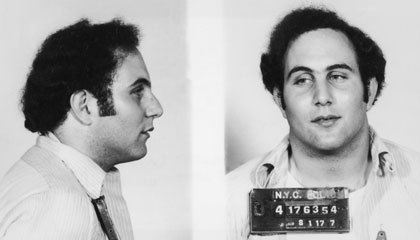 Berkowitz's mug shot at the time of his arrest.
Berkowitz's mug shot at the time of his arrest.Interrogated for a half hour early on the morning of August 11, 1977, Berkowitz confessed the shootings, claiming that a neighbor’s dog possessed by a demon had prompted him to kill. Arraigned in Brooklyn in a courtroom that was packed to the rafters, Berkowitz was quickly sent to the Kings County Hospital psychiatric ward, where the staff reported that he seemed surprisingly untroubled by his confinement. Declared unfit to stand trial by reason of insanity, on June 12, 1978, he was sentenced to 25 years to life for each of his six murders, to be served consecutively in the state’s maximum security prison at Attica.
In a 1979 press conference Berkowitz retracted his claims of demonic possession, calling them a hoax. He told a court-appointed psychiatrist that he had long contemplated murder to be revenged on a world that had rejected him, and out of anger over his lack of success with women. Stalking and shooting women had sexually aroused him, and afterward he would masturbate. This could well be, but whether his earlier belief in demonic possession was simply a hoax seems doubtful.
While at Attica there was an attempt on his life that left a long scar on his neck, but he refused to identify the assailant. Though his parents were Jewish, in 1987 he became a born-again Christian and asked to be referred to no longer as Son of Sam, but as Son of Hope; his conversion seems to be profound and sincere. Transferred to the Sullivan Correctional Facility in Fallsburg, New York, he has shown little interest in his parole hearings and remains there to this day. His good behavior has been noted, as well as his completion of a two-year state university program and several prison rehabilitation programs, and his expression of remorse for his crimes. In a 2012 interview with the New York Daily News, Berkowitz, now white-haired and balding, declared, “Society has to take the glory out of guns.”
Years after his arrest Berkowitz claimed that other members of a Satanic cult shared responsibility for some of the killings attributed to him, but the New York police remain convinced that there was only one gunman, since when Berkowitz confessed immediately following his arrest, he remembered all the shootings, giving details that only the killer could know. And what is one to conclude, when he keeps changing his story? Did he really think he was demonically possessed, or was it a hoax from the start? Did he act alone or with others? Even now he seems to be a victim of fantasy and illusion.
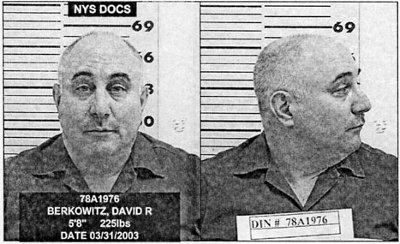 Berkowitz's mug shot, 2003.
Berkowitz's mug shot, 2003.In 1977 New York State passed a “Son of Sam law” to prevent accused or convicted persons from profiting from their crimes by speaking or writing about them, and directing that any such profits, if realized, be used to compensate victims. The law was struck down by the Supreme Court in 1991, but a new law passed in 2001 has to date survived constitutional scrutiny. Similar laws have been passed by 41 other states and the federal government.
The Son of Sam murders have also inspired a novel, a film, and several songs, but without Berkowitz’s consent or approval. And Berkowitz has a website of his own, “Arise and Shine with David Berkowitz,” where he shares his testimony of God’s forgiveness, stressing that if God can forgive the Son of Sam killer, he can forgive anyone.
What is a serial killer? A serial killer feels a compulsion to kill, then after a killing experiences a feeling of relief until, as time passes, the compulsion builds up and makes him kill again. (It is usually, but not always, a “him.”) Those who have studied the phenomenon include these traits:
· Lack of normal family life in their childhood· Lack of remorse or guilt· Impulsiveness· Sensation seeking· A need to exercise control · A need for attention· A mask of sanity hiding a psychopathic nature· Resentment at having been bullied or socially isolated in their childhood or adolescence· A belief they are driven to crime by some imagined entity such as God or the Devil
To what extent did David Berkowitz exhibit these traits? He was born in Brooklyn in 1953, to a Jewish mother, Betty Broder, and an Italian-American father, Tony Falco, who separated before he was born. When the mother became pregnant with her new boyfriend’s child, and the father threatened to abandon her if she kept it, she put the infant up for adoption, listing Falco as the father. The infant was adopted by Pearl and Nathan Berkowitz, a Jewish couple who ran a hardware store in the Bronx and, being childless in their middle years, wanted a child. Though of above-average intelligence, Berkowitz had a troubled childhood and lost interest in school; neighbors and relatives remembered him as difficult, spoiled, and bullying. When, at age 14, he lost his adoptive mother to cancer, he was devastated and became depressed, imagining that her death was part of a plot to destroy him. When his adoptive father remarried in 1971, David and the new wife didn’t get along, and the couple moved to Florida, leaving him behind. That same year, at age 18, he enlisted in the Army and served for a time in Korea, during which he became an expert shot with a rifle. But his only sex experience was with a Korean prostitute who gave him a venereal disease.
After receiving an honorable discharge in 1974, Berkowitz located his birth mother and was greatly disturbed to learn from her that he was illegitimate. More and more he experienced isolation, fantasies, and paranoid delusions, and apparently began setting fires that he later boasted of. He held a series of blue-collar jobs and at the time of his arrest was working as a letter sorter for the U.S. Postal Service.
In November 1974 he wrote a letter to his father in Florida, saying that people he didn’t even know hated him and spat and kicked at him on the street. Later, after his arrest, he would tell how on Christmas Eve of 1975 his demons made him attack one woman and then another with a knife, though the police were unable to verify the first attack. When the barking dogs of his neighbors disturbed his sleep, he turned their barking into messages from demons ordering him to kill. Moving to a new address in Yonkers, he came to believe that his neighbor Sam Carr’s dog was also possessed, and then that Carr himself was possessed by a demon named Sam, and so was born the name “Son of Sam.” By now he was deep into a world of demons howling for blood, and only a killing could – for a while – bring him relief.
If one combines this brief account of his early years with his behavior as Son of Sam, it seems that Berkowitz exhibited, at least to some extent, all the traits mentioned above and therefore was a classic example of the serial killer. Why some people exhibiting some or all of these traits become serial killers and others do not is a mystery that forensic experts and others are still trying to solve. But the fact that serial killers suddenly emerge, terrifying whole populations and often eluding capture for weeks, months, or years, is as frightening as it is baffling.
Coming soon: Al Sharpton: champion of his people or rabble rouser? From agitator on the streets to insider invited to the White House. And after that, great hotels of the past and present, including one where mobsters Bugsy Siegel and Lucky Luciano might have rubbed elbows with an ex-President and the Duke and Duchess of Windsor.
© Clifford Browder 2015
Published on January 25, 2015 04:39
January 21, 2015
162.5. Big Bank, Big Real Estate
This is a note about BIG – BIG as it relates to banking, and BIG as it relates to real estate. Banking first.
JPMorgan Chase and Mr. Dimon
Viewers of this blog know the love I bear my bank, JPMorgan Chase and its CEO, Jamie Dimon. I truly love my local branch, whose staff have been consistently courteous, friendly, and helpful, even if I refrain from sampling the free coffee and candy that they dispense so generously. But as regards the illustrious Mr. Dimon, an undeniably handsome gentleman who looks like the quintessential corporate CEO, impeccably groomed, poised, and authoritative, I confess to a few reservations. Under his leadership, several years ago his bank suffered a grievous $6 billion loss in a single trade, which for me was ample proof that we should bring back the Glass-Steagall Act of 1933, repealed in 1999, which prohibited investment banks, which undertake risky ventures like the trade in question, from doing retail banking, and prohibited retail banks, which deal with the likes of you and me and hold our money, from doing investment banking, with all the risks such banking involves. The lack of such regulation was a major cause (though not the only one) of the financial crisis of 2007-2008. Not that there’s any chance of serious banking reform happening soon.
 Mr. Dimon at a 2013 conference. He looks good in blue. And notice the cufflinks.
Mr. Dimon at a 2013 conference. He looks good in blue. And notice the cufflinks.Steve Jurvetson
 Chase's corporate headquarters at
Chase's corporate headquarters at270 Park Avenue.
Elisa.rolle Now JPMorgan Chase has announced disappointing earnings for the fourth quarter of 2014 and potential new legal costs, and Mr. Dimon is unhappy. “Banks are now under assault,” he has told reporters. “In the old days, you dealt with one regulator when you had an issue. Now it’s five or six. You should all ask the question about how American that is, how fair that is.” He may have a point, but if all those regulators are scrutinizing his bank’s activities, those activities must be suspect; time will tell.
Mr. Dimon is also indignant at the thought – proposed by some investors – that his bank, the biggest in the U.S., is too big, too unwieldy, and therefore that it should be broken up. Their complaint isn’t that JPMorgan Chase is too big to fail – which it certainly is – but that its size inhibits efficiency, an allegation that Mr. Dimon vigorously denies. For him, BIG is good.
And it’s certainly good that his bank’s reported profit for 2014 as a whole was $21.8 billion, a 21 percent increase over 2013, and the highest annual profit in the company’s history. Because this quarter it had to set aside $1.1 billion to deal with an industry-wide investigation of manipulation in foreign currency markets – just the sort of esoteric wheeling and dealing that big banks indulge in and ordinary citizens cannot comprehend.
Big bank, big profits, big investigation, and probably big fines. But the very idea that Chase might have to shrink strikes Mr. Dimon as downright unpatriotic, since it would open the door to foreign competitors. “I wouldn’t want to see the next JPMorgan Chase be a Chinese company,” he states emphatically. The very thought should horrify us all.
The Real Estate Board of New York
Though I’ve been a resident of this city for decades, I had never heard of it. Which goes to show how New York’s immensity and diversity can leave one totally unaware of vital aspects of its economy and culture. But now, in the New York Times of January 15, 2015, it has sponsored a whole 24-page section, discreetly labeled “advertisement,” celebrating its presence and significance. “200 hundred years of experience,” it declares, “and we’re just getting started.” So what is it?
 Their plaque at 570 Lexington Avenue.
Their plaque at 570 Lexington Avenue.Leonard J. DeFrancisci
The Real Estate Board of New York (REBNY), with 16,000 members and dating back to 1896, is the real estate trade association of New York, promoting the industry’s interests and voicing its needs and opinions. Needless to say, it advocates lower real estate taxes, less regulation, and more development. And REBNY and the industry it represents are BIG. For while tourism and fashion and publishing and the media and Wall Street are essential to the city’s economy, real estate is tops. Says Steven Spinola, REBNY’s longtime president, “The most important industry in the city is real estate. Commercial real estate taxes bring in almost twice as much as the personal income tax in the city. These are the taxes that pay for the services that make this city humane, caring, and livable.” So if we deplore Wall Street’s outsized bonuses but have to acknowledge that, through taxes, they boost the city’s revenues, there’s no denying that real estate’s earnings do the same. And it’s worth noting that among the guests attending REBNY’s 119th annual banquet on January 15 at the prestigious New York Hilton Hotel were Mayor Bill de Blasio, Senator Charles Schumer, New York Attorney General Eric Schneiderman, New York City Comptroller Scott Stringer, and other officials, whose illustrious presence there says a lot.
And what is REBNY’s outlook for 2015? At the annual banquet Mr. Spinola announced, “Last year, I characterized the mood of the industry and the city as ‘reserved optimism.’ This year, I will drop the ‘reserved’ and say the mood is optimistic.” Occupancy rates are rising, new development is taking place, and brokers are making deals, all of which indicates great confidence in the city. In a note a week ago I wondered if New York real estate wasn’t a bubble about to burst, but the industry itself obviously scoffs at such a thought. New York City, it asserts, is at the center of a global economy, attracting investors because of its real estate market’s size and diversity, and that market’s quality, stability, and liquidity; above all, foreign money is flowing in. So for 2015, full speed ahead.
And what do those 24 pages of advertisement show? Pictures of towers vaulting into the stratosphere, and glowing messages from real estate firms with captions like these:
CONNECT WITH WHAT’S NEXTMAKING MOVES IN 2014OPEN FOR BUSINESSTOWERING SUCCESS / 1 MILLION SF LEASEDANOTHER TOWERING ACHIEVEMENT
 One World Trade Center in fog.
One World Trade Center in fog.Apricot50
The “towering achievement,” by the way, is One World Trade Center, whose soaring edifice is visible from my bedroom window by day, and whose presence lights up the sky by night. So even if I’ve been woefully ignorant of REBNY and its doings, those doings have discreetly reached to my abode.
So REBNY is all about BIG, BIG, BIG, and BIG at its most modern and blatantly daring, BIG that dwarfs us mere individuals, that seems to leave us out. For those office and residential towers have nothing to do with you or me; they are intended for corporations and individuals who, having billions to spend, are in tune with these heady times.
 A 40-story residential tower at 400 Park Avenue South.
A 40-story residential tower at 400 Park Avenue South. Advertised as "the pinnacle of modern living."
But I wouldn't want to live in a pinnacle.
Justin A. Wilcox
 One Madison Park, at 23 East 22nd Street, advertised as
One Madison Park, at 23 East 22nd Street, advertised asoverlooking "the lush green oasis of Madison Square Park."
Doorman, concierge, swimming pool. Pets allowed.
Average sale $4,562 per square foot.
Fletcher6
 An office tower under construction at 10 Hudson
An office tower under construction at 10 Hudson Yards on Manhattan's West Side. The first of
16 planned high-rises in the area.
Justin A. Wilcox
One photograph, just one, in those 24 pages is a throwback to an earlier age, showing a neo-classical office building at 315 Hudson Street that is only a mere eight stories high – to my way of thinking, human size. Why is this venerable edifice shown? Because it’s being upgraded and the upgrading will include installation of a “green roof.” And what is a “green roof”? A roof with greenery growing in a bed of soil planted over a layer of waterproofing. So bravo for the preservation of an old building and the addition of a green roof. But what really appeals to me about 315 Hudson Street is that I don’t get a stiff neck looking at it; far from soaring, it just sits there, squat and solid. It doesn’t dazzle, it reassures.
Yet I can’t deny that those pictures of soaring towers – those glass and steel needles that spike the sky -- do dazzle. They are today’s expression of Go Ahead, of what I have called the city’s dark eros, its blind urge to push on, its expression of Dream, Dare, Do, the feeling (or illusion) that this city and country can do anything, that the eyes of the world are upon us: the very essence – for better and for worse – of America.
Is this hubris? Will this mood still be with us a year from now, or will the bubble, if bubble there is, have burst? I have no idea. But as always, New York is an exciting place to be.
Published on January 21, 2015 05:18
January 18, 2015
162. Movie Theaters Then and Now: Palace, Sleaze, and Art
The theaters of my childhood
“Our generation needs a name,” a friend once said to me. “Born in the late 1920s and early 1930s, we aren’t part of the Lost Generation or the Greatest Generation, but we aren’t baby boomers either. So who are we?” Then he answered his own question: “We’re the Movie Generation.”
Fair enough. We grew up on movies, just as we grew up on radio, but it was movies that enticed us away from home and immersed us in wonders and horrors. In the Evanston of my childhood first-run movies showed at the Varsity, the most prestigious of the local movie houses – and the most expensive. Inside it was magical, for walls and ceiling presented the silhouette of an Old World city at night with stars twinkling in the sky: a setting almost as exotic and wondrous as the films. After the Varsity came the Valencia, which might get the first-run films a bit later, and after the Valencia, in our end of town, the Stadium, which offered B films but, by way of compensation, double and occasionally even triple features with cowboys or gangsters or other assorted riffraff, and on Saturday afternoons, uninspired serials that were meant to lure you back to see the sequel, though they rarely did.
Taking tickets inside the Stadium was usually some squirt of a teenager who loomed threateningly, asked you your age and date of birth; if they weren’t consistent, he declared, “Your arithmetic stinks! An adult ticket for you next time!” I endured this more than once, for he so intimidated me that I misstated my age or date of birth, even though I was still entitled to the cheaper ticket.
There was something slightly drab and sleazy about the Stadium, and for the best experiences one went to the Varsity. Many a time I took refuge there from the afternoon summer heat (in those days only movie theaters were air-conditioned), immersing myself in some Technicolor epic that swept me away to another time and place where heroes and villains met in mortal combat on battlefields or castle corridors and stairs, always to the villain’s final discomfiture. I saw feuding families exchanging bullets in Kentucky against a backdrop of stunning natural beauty, and British soldiers fighting fanatical dervishes in hot distant places. Then, at the show’s end, I emerged from the magical darkness into the bright hot light of day, often with a throbbing headache that would oppress me all the way home.
Yes, the Movie Generation. My love of movies persisted through high school, and the Varsity one Saturday night witnessed my first timid attempt to put my arm around a girl (I doubt if she noticed, since I chiefly embraced the back of her chair and got a stiff arm in the bargain). During college days in Southern California I abandoned radio altogether but on occasion, having nothing better to do, saw a movie, something I was quite content to do alone, to the astonishment of my more gregarious friends.
Movie theaters in France
Studying in France for two years in the early 1950s, I encountered the Gallic version of the movie experience. No double features there, just one featured film. In provincial Besançon, where I was doomed to study for a year, there was only one little theater, and if it was packed, as it often was on Saturday night, late arrivals had to settle for a strapontin or foldaway seat along the central aisle. Very important: when the ouvreuse (usher) showed you to your seat, you tipped her; failing to do so would earn you a nasty look or even a tart remark. The ads on the screen weren’t too annoying, since they helped me learn French and often had a sense of humor as well. Climaxing many a brief melodramatic scene came the words
Dents blanches, haleine fraîcheSuperdentifrice Colgate!
White teeth, fresh breathSuper toothpaste Colgate! Not even in this desolate little town in eastern France (“un trou,” the French would say) could one escape the international reach of the American toothpaste industry.
After the preliminaries the lights came up and the ouvreuses came down the main aisle, squeezing past the strapontins, repeating in their charming voices, “Demandez ce que j’ai … Demandez ce que j’ai …” (Ask what I have), as they pedaled assorted goodies. Only when they had finished could the main feature begin. And if it was an imported film of considerable length, the film would be ruthlessly abridged, regardless of how that affected the story. In Besançon I saw – and fell in love with – the film version of The Tales of Hoffman, and only on seeing it again in this country did I realize that the entire third act had been cut.
Many of the French were disdainful of Hollywood films, and I’m afraid I had to agree. I usually preferred French films, even the less than brilliant ones, because they helped me learn French. But the Besançon experience, charming as it in some ways was, wasn’t altogether typical. In Paris I saw An American in Paris, starring Gene Kelly and Leslie Caron, with the dialogue dubbed in French (they gave Kelly a charming American accent), in a large theater without commercials or ouvreuses peddling goodies – an experience much like that in an American movie house. And in Lyons I saw Ivanhoe, likewise dubbed in English, also in a large theater minus commercials and peddled goodies. And I’ll have to admit that the film – totally Hollywood – was a rousing good story, if you could settle for spectacle and action. And the French audience seemed to think so, too. And on several occasions while traveling in France I saw, blazoned on marquees, the title Autant en emporte le vent, which I deciphered as Gone with the Wind. Yes, that classic Hollywood spectacle was playing all over the place, proof that the French, though justifiably scornful of much of Hollywood’s output, still had room for a spectacle or two.
Returning from France, I came to New York and immediately broadened my experience of movies and movie theaters. Here I became familiar with three distinct types of theater, none of which I had experienced before: the movie palace, the sleaze theater, and the art theater.
Movie palaces
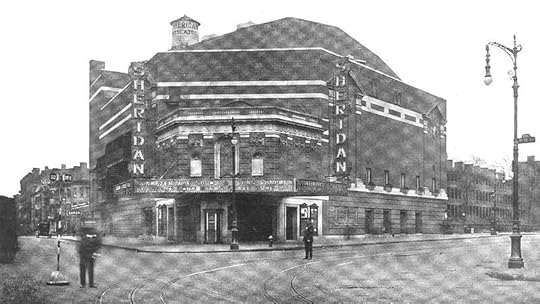 The Loew's Sheridan in its heyday, 1922.
The Loew's Sheridan in its heyday, 1922.For me, the epitome of the movie palace was the old Loew’s Sheridan, which loomed like a hulking monster at the intersection of Seventh Avenue, West 12th Street, and Greenwich Avenue in the West Village, not far from where I lived in the 1960s. Built in 1921, it was once a splendid example of the American movie palace, whose faux luxe (false luxury) I had heard derided in France, without ever having experienced the phenomenon itself. The Varsity back in Evanston had taste and elegance, but was never pretentious or overreaching, characteristics typical of all movie palaces, including the Loew’s Sheridan.
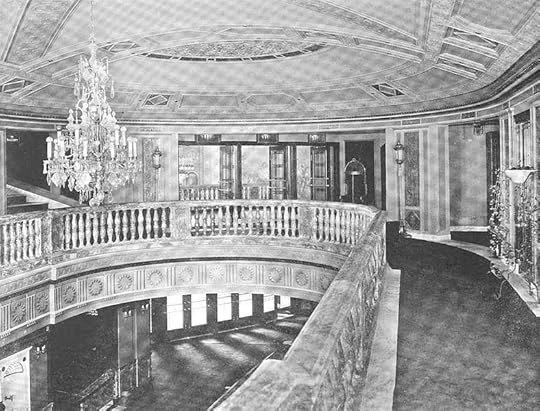 Mezzanine and lobby of the Loew's Sheridan, 1922. I remember nothing so luxurious.
Mezzanine and lobby of the Loew's Sheridan, 1922. I remember nothing so luxurious.That theater’s once sumptuous interior, with over two thousand seats, was immortalized by Edward Hopper in his 1937 painting The Sheridan Theater, showing a woman alone leaning against a railing at the back of the theater, watched from a distance by two figures, one of them an usher. In a hauntingly luxurious setting this painting, like so many of Hopper’s, projects a mood of strangeness, silence, and an eerie calm. This was Hopper’s favorite movie theater, not far from his townhouse on Washington Square, and when he wasn’t in the mood for painting, he would go on a “movie binge,” seeing films daily for a week.
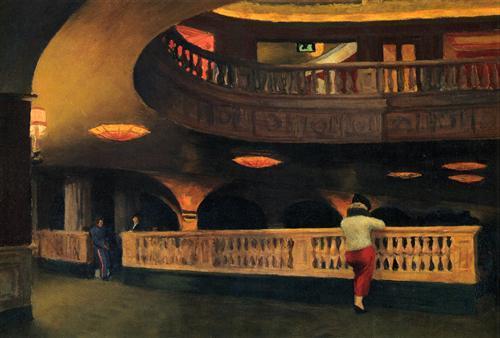 Hopper's The Sheridan Theater. Even in a theater setting, he projects loneliness.
Hopper's The Sheridan Theater. Even in a theater setting, he projects loneliness.Faux luxe there certainly was, for in these old palaces French Baroque might clash with Spanish Gothic or Babylonian or Aztec or Italian Renaissance, with a dash of Egyptian thrown in, after the discovery of King Tut’s tomb in 1922. Pillars rose to rounded arches, walls were richly ornamented, and goddesses cast deadpan stares from niches. Entering such a place immersed one in a world of wonder even before the movie began. Just as nineteenth-century New York had welcomed palace hotels, palace steamboats, and palace railway cars that claimed to give Everyman the luxuries and comforts reserved for the ruling classes in Europe, so twentieth-century New York produced movie palaces worthy of royalty … or at least bogus royalty.
The Loew’s was not my kind of theater – too big, too pretentious, and usually offering grandiose Hollywood or imported films that I could do without. But occasionally some friend lured me there and, against my better judgment, I went. One colossal saga about marauding Vikings was memorable, because one of my two companions insisted on sitting in the loge, the front section of the balcony, for which you had to pay extra. When the usher came to see our ticket stubs, my friend claimed he had lost them but insisted on remaining in the loge. This dismayed me and the other friend, and when we saw the usher return with a policeman we quickly retreated to the rear section of the balcony, from which we saw Vikings depart heroically to plunder and kill their luckless victims. Of the theater itself I don’t remember much, except that it was cavernous and huge, probably long past its prime.
On another occasion my friend Ken lured me there to see some Italian epic of dubious repute. Only when seated inside and watching a horde of young men building what would presumably become a city, did I realize that this B minus film with a cast of thousands was a limp retelling of the story of Virgil’s Aeneid. Ken, alas, was inclined to talk at the movies, and there was little on the screen to hold our attention, so I, alas, against my usual practice, joined in. At this point a burly man sitting in front of us turned around and told us to shut up, which he had every right to do. In reaction I felt a surge of anger seasoned with chagrin, well aware that we had been blabbing, and when Ken suggested that we remove to another part of the almost empty house, I agreed.
The “almost empty house” tells it all. By the 1960s the days of the old movie palaces were numbered, for audiences were deserting the theaters for television, and at the same time abandoning urban centers for the suburbs. Faced with a shrinking patronage, one by one they closed. What then became of them? The Loew’s Sheridan closed in 1969, and Saint Vincent’s Hospital, just across Seventh Avenue, bought its triangular lot and tore it down, planning to build a nurses’ residence on the site. The residence never materialized; the hospital used one part of the lot as a receiving station for supplies, and let the rest become a garden; at this date the lot is still mostly empty. But not all the theaters were demolished. In the 1960s I taught briefly at the Brooklyn campus of Long Island University, and can state with confidence – and lingering amazement – that the main building there was an old movie palace converted to the purposes of higher education.
 The Stanley today, owned by Jehovah's Witnesses.
The Stanley today, owned by Jehovah's Witnesses. The_Grotto
For two summers in the late1950s, while he was in college, my partner Bob worked the late-afternoon and evening shift as a uniformed usher at the Stanley Theater in Jersey City, just off Journal Square. Built as a vaudeville and movie theater in 1928, the Stanley, seating 4,300, was for years the second biggest East Coast theater, surpassed in size only by Radio City Music Hall. Outside, a glittering copper marquee spanned the entrance, overhanging the solid brass doors. Inside, Bob says, it was like visiting the set of the Babylonian sequence of Griffith’s epic silent film Intolerance. He especially remembers the monumental staircase mounting from the lobby to the balcony, flanked by soaring columns. The lobby itself was a huge three-story structure, with rounded arches topped by pillars, and overhead a huge crystal chandelier. The auditorium was flanked on either side by silhouettes of villages with illuminated houses, and on the ceiling overhead there were projections of moving clouds and myriads of stars.
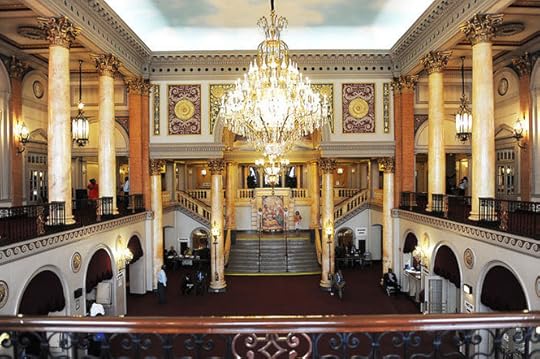 Interior of the Stanley today, with the staircase leading from the lobby to the balcony. Very much
Interior of the Stanley today, with the staircase leading from the lobby to the balcony. Very much what it was in the 1950s.
Yet in that huge auditorium there was only a dwindling audience, for this was the Stanley well past its heyday. Like all the other movie palaces, it was losing business and would have to close in 1978; then, in 1983, Jehovah’s Witnesses bought it to use as an assembly hall. Thousands of the sect’s volunteers worked over a nine-month period to remove paint and dirt from the doors and windows, clean off forty years’ accumulation of nicotine and dirt from the façade, and free the chandeliers from a coating of grime. They succeeded, restoring the old theater to its original long-lost splendor. Once a vehicle for fantasy escape into a lavish world of dream, today the Stanley functions as a genuine house of worship, though at times visitors are allowed to visit it.
For glimpses of what it was like to run one of these old movie palaces well past their heyday, you can’t do better than consult Victoria Hallerman’s blog "Starts Wednesday: Coming of Age in a Movie Palace." Her weekly posts, appearing every Wednesday, are accounts both sad and hilarious of her and her husband’s attempt to profitably operate the St. George Theater on Staten Island in 1976-77. She tells
· How she learned what a standpipe was, and got a friend to become its official operator, as required by regulations· How theaters had to pay a marquee tax, because the marquee was projected over public property, a sidewalk· How Coke syrup spilled on the floor becomes a sticky glue requiring special cleaning· How at Christmas, unable to afford wreaths, they tried to adorn the theater with pine branches, until a fire inspector made them take them down· How in the cold winter they warmed their hands in the popcorn machine behind the concessions stand in the lobby· How people from the neighborhood came by and wanted only to hang out for a while in the lobby, without going in to see the film, and were allowed to do so· How, desperate to increase earnings, they placed a popcorn warmer loaded with buttered popcorn in the heat room, a small room in the bowels of the theater, hoping that the warm air passing from there up through vents into the auditorium would circulate the aroma of popcorn and boost sales – which it did!

And so on and so on, one misadventure after another as they slowly went broke. As I said, both sad and hilarious all at once.
Sleaze theaters
These were the theaters on 42nd Street between Broadway and Eighth Avenue, called “grindhouses,” scandalously close to the Theater District and to Times Square beloved of tourists. When I first came to New York in the 1950s the theaters, once prestigious, weren’t necessarily showing porn as they later did, but the street was populated by junkies and drug dealers, male prostitutes, drag queens, pickpockets, the homeless, and misguided tourists thrilled or, more likely, appalled by what they saw. “I never go to those theaters,” my friend Ken told me, “because someone in the seat next will vomit.” I went just once, as I recall, probably lured by some movie I could find nowhere else. No one in my vicinity vomited, but when I went to the john a good-looking young man was not shy about displaying his anatomy, in which I had no interest; I quickly did my business and got out of there.
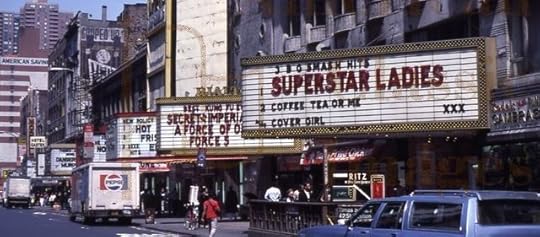
Whenever I found myself in the neighborhood in the evening, I used to walk from Broadway to Eighth Avenue on the downtown side of the street, eyeing marquees and sidewalk scenes of this sleazy but colorful block. Once or twice I had a beer in a bar near Broadway, and on one occasion heard a handsome young blond guy tell an older man, “He treated me like I was dirt!” A hustler, I assumed, telling a prospective customer how another contact had been demeaning; even hustlers – especially handsome young blonds – wanted respect.
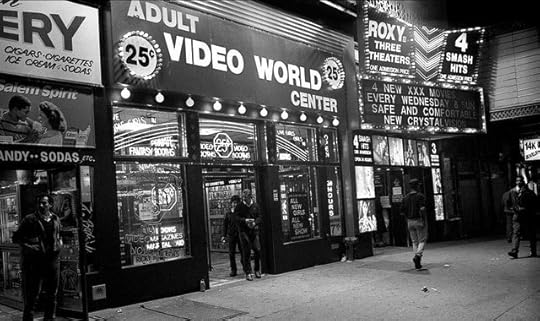
After that the theaters began showing the lowest of B films, including horror movies, monster films, spaghetti Westerns (made in Italy), and porn. Especially porn. THE BEST PORN IN NYC proclaimed one theater sign, and under it, THE ULTIMATE IN ADULT ENTERTAINMENT / CONTINUOUS SHOWINGS. If customers lined up outside a theater showing porn, one enterprising panhandler had a slick technique. He would approach the third man from the front of the line and ask him for a handout. If the man refused, the panhandler would exclaim in a loud voice that all could hear, “You cheapskate! You’ve got money for a dirty film, but you can’t spare me a quarter! What kind of a freak are you, anyway?” Usually the man, embarrassed, would give him some change to be rid of him.
Who were the customers of the young Puerto Rican hustlers who were much in evidence on 42nd Street in those days? Certainly not the junkies and drag queens and homeless. Two gay acquaintances of mine made no bones about patronizing them. One, whom I’ll call Jake, told me of playing “kneesies” with the kid sitting next to him in one of the theaters; sometimes that was the end of it, and sometimes he took the kid home for a joyous bout of togetherness. Even years later he raved about how “cute” some of them were. “There were a lot us,” Jake insisted, meaning other older men with a penchant for Latin youths.
My other acquaintance, whom I’ll call Stewart, also haunted the street in search of young Puerto Ricans, whom he never failed to find. A mutual friend of ours once saw Stewart talking to one of them on the street. Stewart’s face, he said, was transfigured; he was at the pinnacle of joy. “When I connect with them,” Stewart once told me, “I always have a cheap watch on me. Some of them are a bit light-fingered, but if they cop the watch, I just replace it with another.”
One of these kids, named Miguel, became a regular companion of Stewart’s. At a party for his friends that I attended, Stewart put out lots of liquor and a generous spread, but reserved one delicacy for Miguel. When Miguel came, he gaped wide as Stewart plied him with the delicacy in question, a victual of love. The rest of us looked on with smiles, as Stewart took the greatest pleasure in feeding his boy, and the boy reveled in the attention he was getting. That boy, by the way, had a wife and child at home: further evidence of the complexity of human relationships, which reformers and moralists are too often unaware of.
I might add that Jake was a well-educated and congenial citizen with a responsible job in editing, and Stewart was likewise educated, articulate, and congenial, with a well-paid job in vocational guidance. So who were the patrons of the Puerto Rican hustlers of 42nd Street? White middle-class professionals.
My friend Ken, who avoided the theaters for fear of vomit-prone neighbors, loved the wild sidewalk scenes of 42nd Street and was a regular patron of its porn shops, where gay or straight porn of every kind was available, and even short porn films shown in a small room in back. Once, as he approached one of these stores, he heard some black teenagers identify the make of his coat and cite the price it would bring, if they stole it. Unnerved, he quickly entered the store, where they didn’t follow him, so for a while he was able to relax and enjoy its titillating wares. But when ready to leave, he grew anxious again, wondering if he could walk in safety from the store to the nearby subway, which was sure to be crowded and therefore safe. Finally, in desperation, he approached the older black man in charge of the store and offered to pay him to accompany him to the subway. The man agreed, but said to Ken, “Why you dress so rich?” Ken was in fact wearing a costly coat that he could never himself have afforded, a gift from a well-meaning friend. Escorted to the subway, he arrived there with his person and wardrobe intact, but he had learned a lesson. If you want to safely enjoy the sleazy atmosphere of 42nd Street and its porn shops, don’t dress rich.
All this ended in the 1990s, when Mayor Giuliani decided to expel the porn and clean up 42nd Street once and for all. The city took over six of the historic theaters, and the Walt Disney Corporation bought another and renovated it. Gone now are the porn dealers and assorted lowlifes; tourists can range there safely, drawn by the theaters, restaurants, and shops. The new 42ndStreet is respectable and safe, albeit a bit less colorful, less titillating, and less – dare I say it? – fun. Morality always risks being boring. As for those who need the porn and the hustlers, they can find their quarry – quarry that delights in being caught – at other locales throughout the city. And to judge by the websites that lament Giuliani's clean-up and preserve the old 42nd Street in photos, there is a real nostalgia for the now vanished grindhouses and the colorful street life of those days.
Am I glad that 42nd Street was cleaned up and the handsome old theaters renovated? Yes, absolutely, for that street is close to the Theater District and Times Square, where tourists flock. The city thrives on tourists, and many tourists bring their families. Nothing on 42nd Street now should appall them or put them off. And that, I think, is as it should be.
Art theaters
What replaced the old movie palaces were art theaters, small theaters showing one or several films of distinction, usually not Hollywood releases but foreign imports of quality. It began in the 1950s with the Thalia on West 95th Street near Broadway, a small theater that every summer trotted out its stable of quality films. A student then at Columbia, I would walk down Broadway from the campus to see something of interest, as for example Wendy Hiller in Major Barbara and Pygmalion. Already at the Thalia one sensed the special atmosphere of the art theater: a small house with a select audience of college kids and film buffs who showed great respect for the fare being offered; no babble during the film, no crinkling of candy wrappings, no noisy chewing, no Coke syrup spilled on the floor. I had found my kind of theater, the theater where I was most at ease.
When I returned to New York in the fall of 1961, art theaters had proliferated. I recall the Greenwich and the Waverly in the West Village, where I went regularly to see foreign imports by the great filmmakers of the day: Fellini and Antonioni and Pasolini, Kurosawa, and Ingmar Bergman. Fellini delighted me with his portrayals of the dolce vita society of Italy. Antonioni entranced me with his images of Monica Vitti in L’Avventura, La Notte, and L’Eclisse, often against a background of stunning beauty, even if the films lacked action and at times dragged on a bit too long. Kurosawa plunged me into an alien world where a ruthless but well-intentioned samurai triumphed over his enemies, whom his flashing sword could decimate with a few well-aimed strokes that were thrilling to behold and left the ground strewn with severed arms and heads.
Ingmar Bergman’s Wild Strawberries drew me into the aging protagonist’s fantasies and dreams, with recollections of his unhappy marriage, awareness of his loneliness and approaching death, and final sense of peacefulness and joy. Some of Bergman’s films were unrelievedly bleak, but The Seventh Seal, in which a knight back from the Crusades plays chess with Death, absorbed me from beginning to end, with all the characters finally being led away over the hills in a fearful but visually stunning dance of death. Equally arresting was The Virgin Spring, in which a virgin is raped and then killed by two men who then take shelter in the home of the girl’s father, who, when informed of the rape and murder, kills the murderers and their young brother. In the end, the father finds his daughter’s body, and a spring begins to flow from where she had been lying, bringing a strange kind of hope into an otherwise grim story. By way of contrast, his Smiles of a Summer Night is a gentle comedy where the characters are all finally mated in the course of a summer night.
When I mention movie palaces and sleaze theaters, the emphasis tends to fall on the theaters themselves and not on the films that they showed. But in speaking of art theaters it is just the reverse, for art theaters are not themselves visually memorable. They are simply quiet sanctuaries where lovers and historians of film can revel in the treasures of the past.
Films that I saw mostly in art theaters and that I would rate as exceptional:
· Sergei Eisenstein’s Ivan the Terrible, Part 1, and his silent film Battleship Potemkin, portraying the Russian navy mutiny of 1905, with an unforgettable shot, when the Cossacks fire on the people of Odessa, of a baby carriage careening down a long flight of steps. · Antonioni’s Blowup, with an arresting sequence where a filmmaker’s production of a series of blowups of a picture he has taken gradually reveals a gunman brandishing a handgun. Stir-crazy from a long confinement to my apartment with a knee problem, I hobbled out on crutches, caught a taxi to the theater, and was not disappointed by the film.· Pasolini’s Gospel According to St. Matthew, which conveys beautifully the simplicity of the Gospel, free from all the hullabaloo and pretension of a Hollywood film.· Griffith’s silent epic Intolerance, telling four stories simultaneously, with memorable scenes of the fall of Babylon, the St. Bartholomew’s Massacre in Paris, the Crucifixion, and a modern story with suspense right up to the very end. Seen at the Elgin Theater at West 19th Street and Eighth Avenue, with live piano accompaniment.· Abel Gance’s silent epic Napoleon, finally restored and presented in a four-hour version not in a small art theater but at Radio City Music Hall in 1981, shortly before Gance’s death. Actor/dancer Gene Kelly introduced the film.
But why go on? The list is endless.
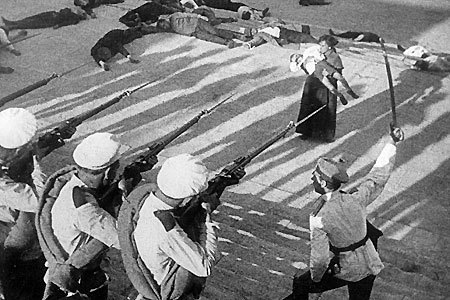 The Czar's soldiers fire on the people in Odessa.
The Czar's soldiers fire on the people in Odessa.From Battleship Potemkin (1925).
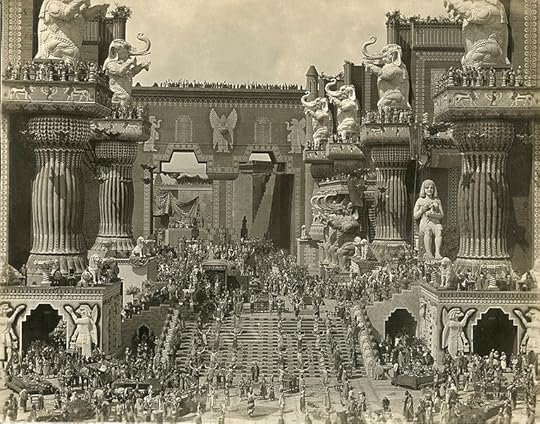 Babylon, in Griffith's Intolerance (1916). And this was long before Cecile B. DeMille.
Babylon, in Griffith's Intolerance (1916). And this was long before Cecile B. DeMille.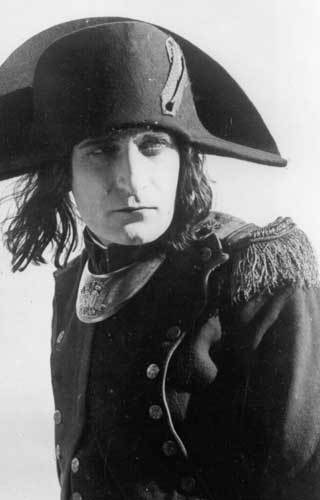 Albert Dieudonné as the young Napoleon in
Albert Dieudonné as the young Napoleon inGance's film Napoleon (1927).
The most crowded theater I ever experienced: one offering as a double bill the Best Actor and Best Actress Oscar-winning films of 1954: On the Waterfront with Marlon Brando, and The Country Girl with Grace Kelly. What ever made me decide to go to a theater that was bound to be jammed? I ended up in a seat far back in the balcony, much nearer the projection booth than the screen.
The emptiest theater I ever experienced: an art theater in the Village in the 1960s, showing an Andy Warhol film at an exorbitant price. Were there even five of us in the audience? The film was a series of improvs: a stud in a fancy clothing store staffed by obvious queers; the stud yawning, as a girl tells in detail how she’ll bake a cake; a woman suggesting that he let her ride on his motorcycle to some trendy far-out scene where they will then go their separate ways; and finally, the stud taking an endless shower. There were humorous moments, but nothing held these scenes together, nothing explained why the stud would put up with these situations.
Sometimes an art theater would take a chance on an independent film, often with mixed results. At the Greenwich I saw an indie that opened with an outdoor scene showing a well-dressed man talking to a girl who was evidently his mistress. “I have this cocktail party,” he explained, as the girl, not facing him, ran her hands over some bushes nearby. There was something “off” about the film from the start. Why weren’t the two facing each other? The mention of a cocktail party seemed odd. Already a few titters were heard from the audience. As the film progressed, the titters became guffaws. In the climactic final scene that same man, now clearly the villain of the film, was seen climbing up a ladder to a parapet above, where his mistress, now enraged, was waiting; as he almost reaches what he thinks is safety, she flings him down to his death. Corny, melodramatic, clumsily motivated, stupid. Management took note and canceled the film at once.
Another indie, also at the Greenwich, opened with shots of the Statue of Liberty and the Empire State Building, followed by these words across the screen: “An unidentified city…” Howls of laughter from the audience. We knew at once that this film was going to hold us and afford a constant stream of laughs, which it did. I don’t recall the name of it, but if it turned up somewhere today, I’d rush to see it again.
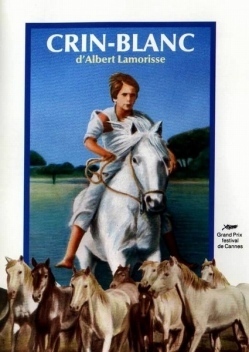 Poster for Crin-Blanc. Today I go occasionally to a film at the Film Forum on Houston Street, where in the last year or two I saw Z, a 1969 French film with a brief but gripping performance by Irene Papas as a grieving widow (the film itself seemed dated), and Crin-Blanc (White Mane), Albert Lamorisse’s brilliant short 1953 film about a stallion with a white mane that leads a herd of wild horses in the Camargue, a marshy region in southern France, and resists all attempts by French cowboys (yes, there really are French cowboys) to capture and tame him. But where I’ve seen the most films of note over the past several years is the Museum of Modern Art, which shows both classics of Hollywood and memorable films of the silent era not otherwise available.
Poster for Crin-Blanc. Today I go occasionally to a film at the Film Forum on Houston Street, where in the last year or two I saw Z, a 1969 French film with a brief but gripping performance by Irene Papas as a grieving widow (the film itself seemed dated), and Crin-Blanc (White Mane), Albert Lamorisse’s brilliant short 1953 film about a stallion with a white mane that leads a herd of wild horses in the Camargue, a marshy region in southern France, and resists all attempts by French cowboys (yes, there really are French cowboys) to capture and tame him. But where I’ve seen the most films of note over the past several years is the Museum of Modern Art, which shows both classics of Hollywood and memorable films of the silent era not otherwise available.Couples who once left the city to raise their children in the suburbs are now, with their children grown, moving back into cities. Why? Because they miss the cultural wealth of the cities – the concerts, museums, galleries, theaters, and dance. And the opportunity to see old movies that may not turn up on television. For this, you can credit MOMA and the art theaters. And since I don’t have television, where else could I see some of the dimly remembered movies of my childhood, the films that I missed, and the often forgotten classics of the silent era – works of Griffith and Eisenstein, comedies of Chaplin and Buster Keaton, and Erich von Stroheim’s overlong but brilliant epic Greed.
I will always be haunted by the end of Crin-Blanc, where the white horse and the boy who has befriended him dash off into the sea, escaping forever the pursuing ranchers. And the end of von Stroheim’s Greed, where the two antagonists are locked in a final struggle in the desert, the survivor handcuffed to the corpse of the other, without horse or water, doomed. For these memorable images I am beholden to the art theaters of New York.
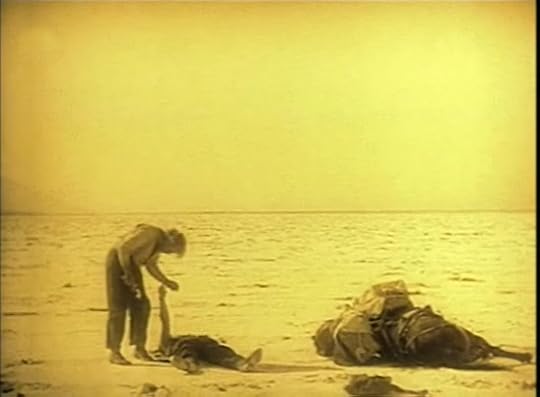 The final scene in von Stroheim's Greed (1926).
The final scene in von Stroheim's Greed (1926).But the film was in black and white.
Coming soon: Next Wednesday, two notes on BIG: a big bank (JPMorgan Chase), and big real estate, as embodied in REBNY. Never heard of REBNY? Until recently, neither had I, but I should have. And next Sunday, Son of Sam, and I’ll bet that you have heard of him.
© 2015 Clifford Browder
Published on January 18, 2015 04:48
January 14, 2015
161.5. Four Notes: Physicals, Charlie, Real Estate Bubble, World War I
Surprise, surprise! This mini-note, squeezed in on a Wednesday, comprises four notes about matters on my mind that, if added to the next post, would burden it unduly. So I’ll disburden here and let the forthcoming post on movie theaters proceed with joyous abandon.
Note on annual physicals: “Skip Your Annual Physical” is the title of an op-ed article by Ezekiel J. Emanuel in the New York Times of January 9, 2015. The author, an oncologist and a vice provost at the University of Pennsylvania, asserts that most annual physicals are worthless, so that if we all skip them we can help reduce health care costs. In 1994 I had no symptoms of anything, but my routine annual physical revealed that I was slightly anemic. “If you were a menstruating woman I wouldn’t think twice about it,” said my physician, “but in a man it’s suspicious.” She immediately ordered a colonoscopy – my first – and the procedure discovered a malignant tumor the size of a golf ball. The surgery that followed removed the tumor, but metastasis – the spreading of the cancer beyond the colon – had just begun. Chemotherapy was recommended to prevent recurrence, but I preferred a nutritional approach instead, with lots of cruciferous vegetables, garlic, and soy foods; the cancer never returned. Many annual physicals may reveal nothing at all, but mine saved my life. I tried to send a short letter to the editor to the Times, making this point, but the e-mail was immediately rejected unread. My advice to all: have your annual physical and rejoice if it reveals nothing; omitting it could put your life at risk.
I am not Charlie: In the wake of the terrorist attacks in France, 40 presidents and prime ministers and a million people marched in the streets of Paris on Sunday, January 11, in solidarity with Charlie Hebdo. (Conspicuous by their absence, incidentally, were our President, Vice President, and Secretary of State. ???) Many of those marching flaunted signs declaring JE SUIS CHARLIE. But are they? And are we?
Charlie Hebdo espouses a kind of satire that is savage, provocative, ruthless, and sophomoric. As David Brooks has pointed out in the Times, had they tried to publish one of their issues on the campus of an American university, protests would have erupted with cries of “Hate speech!” resounding, and they’d have been shut down in an instant. We Americans simply don’t tolerate this kind of deliberately offensive humor. “In America,” one of my Columbia professors, a Frenchman, remarked long ago, “jokes about religion are unwelcome.” True enough, and now one might add jokes about ethnic and sexual minorities as well. We believe in tolerance, even if we don’t always practice it, and therefore frown on the kind of mockery that Charlie Hebdo specializes in. Which is not to say that we approve of Islamist extremists; we march in spirit with the Paris protesters, whether we identify with Charlie or not.
Charlie Hebdo, as I understand it, is a throwback to the 1960s and its mood of feverish protest, and something of an anachronism today. In fact, prior to the recent attack it was dwindling down and probably destined for a quiet extinction. But the terrorist attack has vaulted it back into prominence and given it new life. Before the attack its circulation per issue was about 60,000; just today they have brought out another issue, the first since the attack, with an anticipated circulation of 3 million; the first million copies sold out at once. The issue shows the prophet Mohammed carrying a sign JE SUIS CHARLIE. But this raises an interesting question: should the state have to devote precious resources to the protection of a publication that is determinedly and willfully offensive, especially when those offended are present in France in large numbers? Well yes, of course, but … Hmm, I think I’ll let the French puzzle this one out. But even if I sympathize with it in the wake of the attack, I am not Charlie Hebdo.
Another real estate bubble in New York? I know little about real estate, don’t even glance at the Real Estate section of the Sunday Times. But something on WNYC struck me the other day. The station has been doing a series on the local real estate scene and its skyrocketing prices entitled “Who’s Buying New York?” On this program, of which I heard only the very last part, a real estate agent being interviewed said that real estate in the city in 2014 had been “on steroids.” And 2015, she confidently predicted, would be even hotter. And 2016? “Don’t ask.”
Curious, I googled “real estate bubble, New York” on my computer and immediately came up with a bunch of reports. For instance:
· On November 6, 2014, the New York Daily News quoted Ofer Yardeni, CEO of a prominent real estate development firm, as saying that the New York residential property market is a bubble about to burst. “I would very happily short 57thStreet,” he said, referring to the high-end towers surging up along 57thStreet’s “Billionaires’ Row.” Super luxury apartments are multiplying, but no one knows if there are enough wealthy foreigners out there to buy them.· On August 5, 2014, hedge-fund manager Todd Schoenberger announced that the New York real estate market, fueled by foreign buyers, was hot, hot, hot – a bubble waiting to pop.· On April 15, 2014, real estate broker Robert Knakal said that he was frequently asked if the commercial real estate market had become a bubble. Acknowledging arguments both pro and con, he concluded, “The jury is still out. Only time will tell. Until then, let the fun continue.” (This, of course, was months ago, well before the preceding two observations.)
And so on and so on. Some knowledgeable observers say yes, some say no, and some say maybe. And who is buying these properties, or putting up new ones? It’s not easy to say, since often the listed owner is a shell company that conceals the names of the buyers. But everyone agrees that the boom is fueled above all by foreign buyers, especially Chinese, who are now allowed to take money out of the country and are eager to invest abroad. Many of these buyers don’t live here and don’t pay personal income taxes, and their eager buying, usually for cash, is driving prices constantly up. Some of these absentee owners keep the property as a “pied-à-terre” where they can rest their weary bones during brief visits to the city, while others simply rent the property out. There is a bill now pending in Albany that would impose an annual “pied-à-terre” tax on properties worth $5 million or more, but who knows if it will pass?
Symbolic of the current boom is a skinny building at 432 Park Avenue that soars 1,396 feet, making it the tallest residential tower in the Western Hemisphere, topping both the Empire State Building and 1 World Trade Center minus their spires. Visible from almost anywhere in the city, this new building has been described by local journalists as a “dried piece of spaghetti,” a “giant matchstick,” and a “cornstalk in the middle of a vegetable patch” – one worthy of a “toothpick award.” All of which suggests a less than enthusiastic reception. It’s offering luxury apartments, of course, with breathtaking views, but at least it was put up by American developers.
So what am I, a layman, to make of all this? Does it even affect me? Now, no. But a collapse in real estate prices has a way of sending ripples through the whole economy, often with dire results. Maybe a popping of the bubble is imminent, maybe not. But the very thought of it makes me nervous.
Note on World War I: Last year was the centennial of the outbreak of World War I, so much has been written about that conflict. Recently the Times Sunday Travel section had an article by an American journalist who visited sections of northern France where you can still see the vestiges of the trench warfare that dragged on for years. The Germans were far ahead of the Allies in their trenches and fortifications, which included a narrow-gauge railroad to distribute supplies, and underground recreation centers for the troops; whatever meticulous, sophisticated planning could provide, they had. Small wonder, then, that they held fast against all Allied attacks until the summer and fall of 1918, when they were finally dislodged from their elaborate defenses and forced to retreat. The journalist asked the older residents in several villages what finally forced the Germans out. Always the villagers answered, “Les Américains.”
Coming soon: As previously announced, Movie Theaters Then and Now: Palace, Sleaze, and Art.
© 2015 Clifford Browder
Published on January 14, 2015 05:28
January 11, 2015
161. Forbidden Houses
As a kid I was fascinated by forbidden houses. In suburban Evanston, a very genteel and unthreatening suburban community, there were two kinds: houses under construction and houses ripe for destruction.
At the end of our one-block street, toward the end of World War II a victory garden suddenly gave way to workmen gouging out an excavation, pouring cement for a basement, rearing up skeletons of walls, installing a second floor and the beginnings of a roof. Which meant that, after a long hiatus brought on by the Great Depression, residential construction was resuming at last, even before hostilities had ceased. And next to the first construction site more workmen started building a second house right smack next to the first.
On warm summer evenings, long after the workmen had departed but when light still lingered, and on Sundays when no workmen appeared, all the kids in the neighborhood, myself included, were drawn irresistibly to the construction sites and began poking, climbing, crawling over the half-finished houses. Probably a warning was posted somewhere forbidding just such intrusions, but none of us noticed or cared. It was thrilling to explore the finished first floor, with its vertical beams marking walls-to-be; to peer down into the dark depths of the basement; and, not without risk, to climb warily up a ladder to the second floor, with gaping holes below that might reach all the way to the basement. It was an adventure to climb up, but coming down was riskier, and you could see the gaping space below you. None of us was ever injured, but with hindsight I can see that what we were doing courted danger. One weekend I didn’t venture into the houses, but many others did, and were caught when the police arrived and took down their names, so they could notify the families. This intervention put a damper on our adventures, and in time the houses were completed, sold, and occupied; the new residents had no realization that their domiciles had once drawn all the kids in the neighborhood like a magnet.
As for the houses ripe for destruction, they loomed up here and there, the contents emptied: strange hulking presences that likewise tempted me and some of my friends to explore them. The floors sagged, gaps in the flooring gaped, and everything about the structure suggested a crumbling haunted house. Again with hindsight, I marvel that none of us ever fell through a hole to the basement or was otherwise injured. I don’t recall any posted warnings; perhaps it never occurred to anyone that a crumbling structure soon to be demolished would attract the young and spice their lives with adventure.
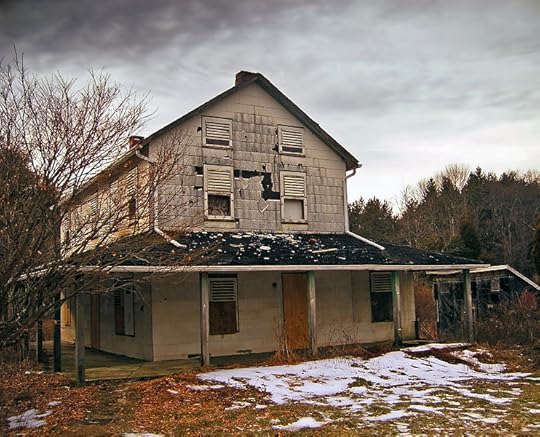 Just the kind of house that lured us, though this one is in a rural setting.
Just the kind of house that lured us, though this one is in a rural setting.Nicholas A. Tonelli
One of these crumbling houses proved indeed to be haunted. Three of us, now in our teens, ventured by chance one night into a deserted old house without even a flashlight to guide us. When we groped our way into what must have been the living room, in search of what we didn’t even know, suddenly one of us asked the others, “What is this?” With his foot he was gently prodding some soft unseen lump on the floor.
Eerily out of the darkness came a man’s voice: “It’s a human being, son.”
We froze, speechless. Some vagrant – in middle-class Evanston they were a rarity – had taken refuge there, hoping for a good night’s sleep, only to have his sanctuary invaded by a trio of teen-age interlopers. Saying nothing, we tiptoed away. Minutes later we were out on the street, and so was he, routed from his sanctuary. He walked slowly on ahead of us, in the very direction we were going, and out of sheer curiosity we followed him. A block or so later he turned to confront us, a big stick in his hand.
“Why are you following me?” he asked, a mix of anger and suspicion in his voice.
“We aren’t!” we protested, mouthing what was only a half lie, since we were going that way anyhow and had no intention of harming him.
He eyed us warily a moment, then turn and continued on his way. This time we didn’t follow him, intimidated just a bit, and perhaps chagrinned slightly at having robbed him of his refuge and his sleep. And that was the only haunted house adventure of my childhood, and a tame enough one at that.
Two other forbidden houses fascinated me in Evanston. Walking home from grade school, I often passed a castle-like stone house with a tower that had a narrow stairway winding upward round its surface. Those stone steps intrigued me: where did they lead? On them I could imagine Robin Hood and the villainous Sir Guy of Gisbourne engaged in a climactic duel that only one of them could survive. One day, summoning up my courage and hoping no one was home, I approached the tower and began mounting the narrow steps. As they curled round the tower, I discovered that they simply came to an end, the other steps having over time crumbled away. Quickly I retraced my steps and left the premises, aware now that the steps led nowhere and maybe never did. But the castle-like house still fascinated me.
I never saw the other house but got reports from my brother, who ranged far and wide on his bike. He told me of a handsome old house near the lakefront occupied by an aging recluse who lived alone and had no visitors; receiving all her supplies by delivery, she was never seen outside. Adjoining the house was a garage, and on the driveway leading to it there was an old car that had been there for decades, exposed to all the elements and slowly, like the resident, decaying with age but, unlike her, visible to all.
Of course there was a story. Long ago she and her young husband had returned from their honeymoon and moved in. The very first day they were there, he for some reason lingered in the garage with the car’s motor on, until he was overcome by monoxide and died. This sudden tragedy plunged the bride into a state of shock from which she never really recovered. From that day forth she never left the house and was never again seen by her neighbors. Removed from the garage, the car still sat on the driveway, a grim reminder of the tragedy of years before. In time the car, the house, and the recluse became a legend.
My fascination with forbidden houses did not end as I reached man’s estate, but it submerged for years, even decades, as my attention was drawn to a myriad of other preoccupations and adventures. But recently the possibility of a forbidden house right here in New York City was awakened in me by an article in the New York Times. It told how, four decades ago, a 19-year-old photographer named Bob Troiano was cruising in his Volvo along Richmond Road in the New Dorp section of Staten Island when he happened to notice, at no. 2475, behind a rusted iron gate and a centuries-old stone wall, an old Italianate mansion, its entire façade fronted by a spacious portico, its roof topped by a cupola. For Mr. Troiana, it was love at first sight.
“You knew it was a forbidden place,” he later explained, “but also unforgettable.”
Not until 1990 was he able to buy the house and pass through the forbidden gate, which by then was rusted shut. The 20-room mansion, he now knew, had been built in 1855 by a commander of the New York militia who in 1889 sold it to a German American confectioner named Gustav Mayer. Mayer’s daughters Paula and Emily never married, for no man was good enough for the father, but the sisters lived on in the house, painting frescoes of their travels on the walls. In their later years they too became recluses, confining themselves to their second-floor bedrooms and lowering baskets from a window to collect groceries, mail, and laundry. Finally, in the 1980s, they and their nurse moved out.
The house Mr. Troiana had bought was in a state of advanced decay. It took him a whole year just to make two rooms on the first floor livable for himself, his wife, and his daughter. Next, he set to work on the rest of the house, tearing down unsteady walls, stabilizing those worth saving, and rebuilding the windows with their original wavy glass. To preserve an authentic atmosphere, he hid all utilities, all switches, outlets, and ducts. Except for the renovated first floor where he lived, the house was preserved in a state of controlled decay, with chipped paint, cracked plaster walls, exposed beams, handsome marble fireplaces, and ornate molding.
As word of the house got out, Mr. Troiana was approached by agents wanting to use the house as a setting for fashion illustrations and articles. Yes, the fashion industry, though obsessed with the newest and latest, was enamored of an old house with an eerie atmosphere. Hostile to the idea at first, in time Mr. Troiana agreed. Since 1992 scores of models have been photographed there, including one descending a staircase with a madman in distant pursuit.
Will these fashion shots and the house’s notoriety persist? Maybe not. Mr. Troiana has put the mansion up for sale for $2.31 million – admittedly, a rather steep price, though it includes a free exterior renovation by himself. He is thinking of relocating to the Southwest, but if he can’t get his price, he’s quite willing to live on in the house. Many editors, directors, and photographers hope that he will stay.
What makes a house forbidden? Mystery, crumbling grandeur, a hint of danger or scandal or the sinister. It may attract you or repel you, but either way you can’t ignore it.
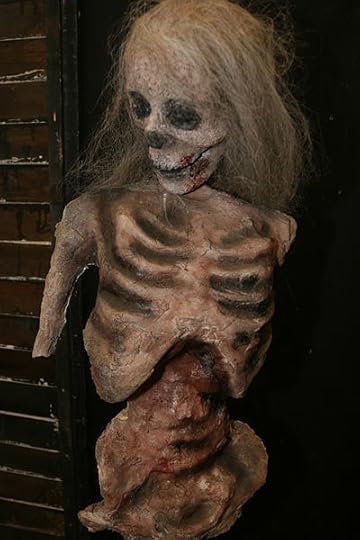 A skeleton in the Monster Manor, a nonprofit
A skeleton in the Monster Manor, a nonprofithaunted house built each year by volunteers
in San Diego and open to the public. One variant is the haunted house, which I became aware of in my childhood through films and radio, this last conveying it through creaking doors, sinister footsteps, and whispers or screams in the night. The haunted house probably dates back to the advent of the Gothic novel in eighteenth-century England, with melodramatic tales of horror set in half-ruined medieval (or pseudo-medieval) castles and abbeys – a vogue that persisted well into the nineteenth century and that even, with variations, survives today. Nineteenth-century literature made good use of it; think of the role of the mysterious house (not necessarily Gothic) in Hawthorne’s House of the Seven Gables, Poe’s Fall of the House of Usher, and Charlotte Bronte’s Jane Eyre. Not to mention the English country houses to which Sherlock and his sidekick Watson were summoned, when some baffling mystery required a rational solution. And for a twentieth-century haunted house one can’t do better than Faulkner’s short story “A Rose for Emily,” which I strongly recommend to anyone not put off by a touch of the morbid.
For me, conditioned by film and radio, the classic haunted house is a three- or four-story Victorian mansion with gingerbread molding, numerous balconies, dormer windows sprouting from steep roofs, towers and turrets topped by conical roofs, and often a cupola at the very top. It must have many rooms where secrets can fester, ghosts stalk. A prowling malefactor would feel cramped in a bungalow, inhibited in a duplex.
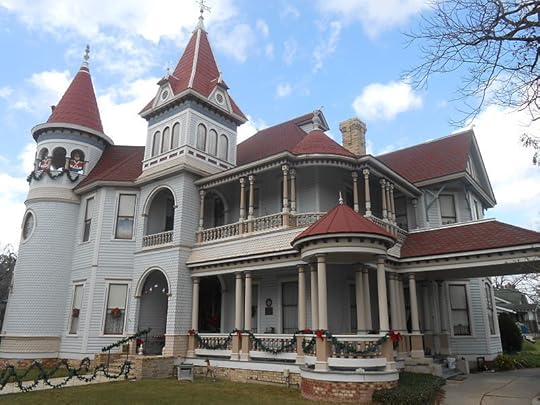 ProfReader
ProfReader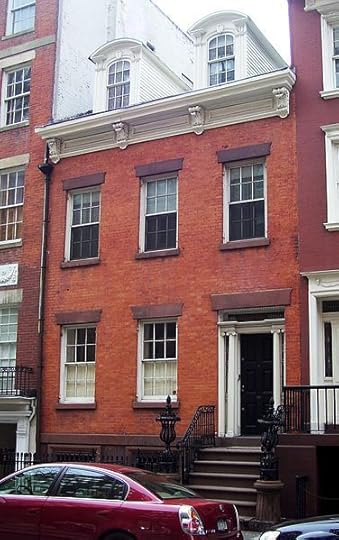 A Federal-style house on West 10th Street
A Federal-style house on West 10th Street today. Brownstones had elegance, Federal-
style houses had charm.
Beyond My Ken There was little room for classic Victorian mansions in the congested city of New York, but its history offers several forbidden or mysterious residences. In the 1830s and 1840s the most desirable residential area in the city was Bond Street, which ran the short distance between Broadway and the Bowery. Its elegant red-brick Federal-style row houses had marble street-front trim and sloping roofs with two dormer windows. Here on this quiet, tree-lined street lived the city’s elite: prosperous merchants and bankers, former cabinet ministers, an ex-Secretary of the Treasury, Congressmen, and briefly, Major General Winfield Scott, whom the Mexican War would soon vault to fame. But by the 1850s the fashionable residents had decamped, put off by insidious signs of decay, notably a proliferation of dentists’ offices, and regarding one of these there hangs quite a tale. For even in this neighborhood, once the very epitome of taste and propriety, scandal and violence could erupt.
Residing at no. 31 Bond Street in 1857 was Dr. Harvey Burdell, a dentist of exceptional skill and the author of several authoritative works on dentistry. He was also, it would seem, quick-tempered and quarrelsome, and may have been guilty o/f sexual predation and real estate fraud. He lived on the floor above the parlors, with his office in the rear room on that floor. Somehow he had made the acquaintance of Mrs. Emma Augusta Cunningham, a widow with four children, who then moved into the building with her family to become his housekeeper … and, it would seem, his mistress. He leased the house to her and she ran it as a boarding house – another precipitous downward step for the once exclusive neighborhood. But Burdell’s relationship with her was a stormy one. She wanted him to marry her, but he was not inclined to do so. He accused her of theft of a promissory note, and she had him arrested for breach of promise of marriage and slander, though these disputes were settled out of court. But her lease would expire on the following May 1, at which time he planned to lease the building to another tenant and so be rid of her.
On the morning of Saturday, January 31, 1857, the young man employed by Burdell to take care of his office discovered, upon entering, the body of his employer lying dead on the office floor in a large pool of blood, his features black, his tongue protruding. Physicians and the police were summoned, and further investigation revealed blood on the floor and walls of the hall outside, and a bloodstained sheet and nightshirt in a storeroom in the garret. The doctor who examined the corpse concluded that Burdell had been strangled by a cord, but also noted fifteen deep wounds in the body. The heart was pierced in two places, both lungs penetrated, and the carotid artery and jugular vein severed. There had obviously been a struggle, yet no one in the house reported hearing any screams.
A coroner’s inquest followed and continued for two weeks amid tremendous excitement. Thousands attended Burdell’s funeral at fashionable Grace Church, and at the inquest Mrs. Cunningham threw herself on the casket and exclaimed, “Oh, I wish to God you could speak and tell who done it!” She then testified that she had married Burdell secretly in 1856, and as verification produced a marriage certificate signed by a Dutch Reformed minister who, when called to testify, recalled the marriage but could identify neither the victim nor the housekeeper; it now seems likely that the groom was another man impersonating Burdell. Other witnesses stated that Burdell had been in fear of assassination, and that Mrs. Cunningham had boasted that “she had a halter around his neck and he had to do what she wanted him to.” The coroner’s jury concluded that Mrs. Cunningham and a boarder named John J. Eckel were principals in the murder, following which she was indicted for murder. Press and public hailed the finding, but at her trial in May 1857, thanks to the efforts of her skillful attorney, she was acquitted for want of solid evidence linking her to the crime. As a result, the case against Eckel, who may also have been her lover, was dropped.
But that was not the end of it. If Mrs. Cunningham could prove marriage with the dentist, she would be entitled to a wife’s share of his estate of $100,000, and if she bore him a child, she would inherit the entire estate. Conveniently, she began to show signs of pregnancy, and in due time a child was received from Bellevue Hospital with the aid of an attending physician. But the physician revealed that he was working with District Attorney A. Oakey Hall, the dapper future mayor, to exposed this fraud, following which Mrs. Cunningham was again arrested. Her attorney got the charges dismissed for lack of evidence, but the Surrogate’s Court ruled that she and Burdell had not been legally married, so she could not inherit from him; for a while she left the city. It also came to light that Mrs. Cunningham’s previous husband, a wealthy distiller, had been found dead one day in his chair, following which she had collected his life insurance in the amount of $10,000. But the fact remains that in the Burdell case the evidence against her was hearsay. As for Eckel, he seems to have ended his days in prison. In a memoir published in 1897, forty years after the murder, Mrs. Cunningham’s attorney, Henry Lauren Clinton, reviewed the case in detail and still maintained her innocence and the validity of her marriage to Burdell, while deploring the fraud of the bogus baby.
The Burdell murder was never solved. Burdell and Mrs. Cunningham, who died a pauper in 1887, both lay buried for years in unmarked graves a few hundred yards apart in Green-wood Cemetery in Brooklyn. In 2007, at the instigation of an amateur historian, both were given handsome granite headstones.
The headstones can be the final word on this sensational case. One wonders how the next tenant of no. 31 Bond Street felt, upon taking possession of the house on the May 1 following. Could they ignore the scandal and trial that had so obsessed the city for months, and the report of floor and walls smeared with blood? What had been a seemingly respectable Federal-style residence, differing little from other such structures on the block, might be viewed by some as cursed, a forbidden house indeed.
Another nineteenth-century structure meriting the label of “forbidden house” was the Old Brewery, reputedly the city’s worst tenement, located near the Five Points, reputedly the city’s worst slum, which I have already mentioned in post #25 (Sept. 22, 2012). Built in 1792 as a brewery, a new owner – said to be a respectable church deacon, but certainly an enterprising gentleman – bought it in 1837 and partitioned it into small apartments so as to get income from rents. By 1850 the dilapidated building was notorious, its three hundred residents including thieves who disappeared into a maze of dark hallways where the police hesitated to follow, as well as real and fake crippled beggars, drunks, harlots, and the very poor. A dark, narrow lane running beside it was known as Murderers’ Alley, in confirmation of rumored murders on the premises, as well as tunnels and hidden rooms housing buried treasures and buried bodies.
In 1850 the New York Ladies’ Home Missionary Society of the Methodist Episcopal Church established a mission school in the neighborhood and held temperance meetings there as well. In 1851 the Reverend Luckey, formerly the chaplain to Sing-Sing State Prison, came to the Mission and began visiting the people in the area, giving counsel and helping them find work. One night in the winter of that year he was summoned to attend a dying man in the Old Brewery. Though the hour was late, he and one of the mission converts went, groped their way up creaking stairs, and were led to a small room near the attic, where a sick man begged Luckey to take him out of there to a place where Jesus could come. Luckey got him admitted to the City Hospital, where he married him and his common-law wife before the man, relieved at being free of the brewery and close to his Maker, died in peace.
So began the work of the Methodists to reclaim the Old Brewery and its inhabitants. In spite of the place’s reputation, the Mission ladies penetrated its cellars, dark passageways, and attics, conversing with the occupants and leaving tracts. At first hostile and suspicious, a man named Brenan who kept a ground-floor grocery and liquor store next door was won over by the visitors, became a friend to the Mission, and gave up his liquor business for another job.
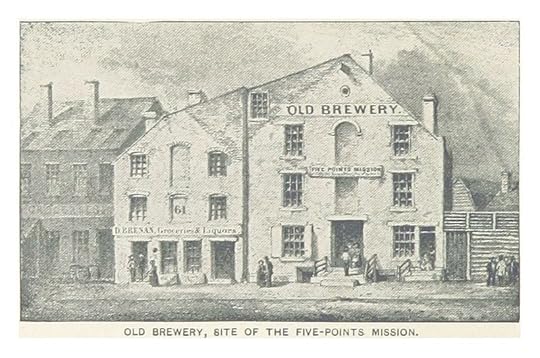 Brenan's liquor grocery can be seen on the left.
Brenan's liquor grocery can be seen on the left.In 1852 the Missionary Society bought the Old Brewery for $16,000. Rumors were still rife about buried treasures in cellars and passageways, as well as vestiges of crime. When a man who had rented a dark, low cellar, ostensibly to store vegetables, gave it up a month later, saying it was too damp for storage, behind him he left evidence of recent digging and the removal of a heavy object from the ground by a tackle. Toward Thanksgiving the Society opened the Old Brewery to the public, who came by hundreds to explore the premises by candlelight, peering into damp, moldering rooms, now empty, and through breaches made in the walls to give free passage throughout. So the forbidden building became known to the public at last. What became of its former occupants is not recorded. The purpose of the Methodists was not to preserve the Old Brewery but to tear it down and replace it with a brand-new Mission building.
Demolition began in December 1852. While it was underway two well-dressed men appeared who tried to bribe the night watchman to let them enter the building; the following night they returned, began probing a soft spot in the yard, but fled upon discovering that the watchman had summoned a policeman. Several nights later the watchman interrupted five men in the yard who fled, leaving behind some tools for digging. Some time after that the men evidently returned, escaped detection, and removed some object, leaving behind the hole they had dug. All of which suggests that the rumors of buried treasure – or at least of stolen goods – may not have been pure legend. As for buried bodies, when, before the demolition, the floorboards of one room were removed, human bones were found underneath. Replacing the demolished structure was a new Mission building, a five-story brick building with rooms at a low rent for deserving families, a schoolroom, and a chapel. So ended the saga of the city’s most notorious tenement.
Yet the most forbidden house of that era was not the Old Brewery, but a palatial brownstone on the Fifth Avenue at 52nd Street, for this was the residence – and basement office – of Madame Restell, the city’s most notorious and most successful abortionist. Needless to say, the Avenue’s fashionable residents were shocked by her pursuing her occupation in their very midst, and only two blocks from the rising walls of Saint Patrick's Cathedral. That story has been told in part elsewhere (post #86, Sept. 22, 2013), so I won’t repeat it here, only to say that the neighbors and passersby, imagining grisly horrors inside, labeled it a House of Death. This scandal ended only with Restell’s arrest and subsequent suicide in 1878, following which her grandchildren, upon inheriting the mansion, turned it into the Langham Hotel. One wonders who the guests might have been, given the building’s history. But the hotel continued for decades, probably offering a quiet but luxurious alternative to the hurly-burly of Broadway.
 Madame Restell's brownstone mansion at Fifth Avenue and 52nd Street.
Madame Restell's brownstone mansion at Fifth Avenue and 52nd Street.Coming soon: Movie Houses Then and Now: Palace, Sleaze, and Art. You’ll learn what a strapontin is, how Spanish Gothic could be combined with Babylonian, why theaters pay a marquee tax, who patronized the hustlers of 42nd Street, the most crowded and the emptiest movie theaters I have ever been in, and two haunting movie endings: Greed and Crin Blanc. And after that, terrorism, New York style: Son of Sam.
© 2015 Clifford Browder
Published on January 11, 2015 04:41



